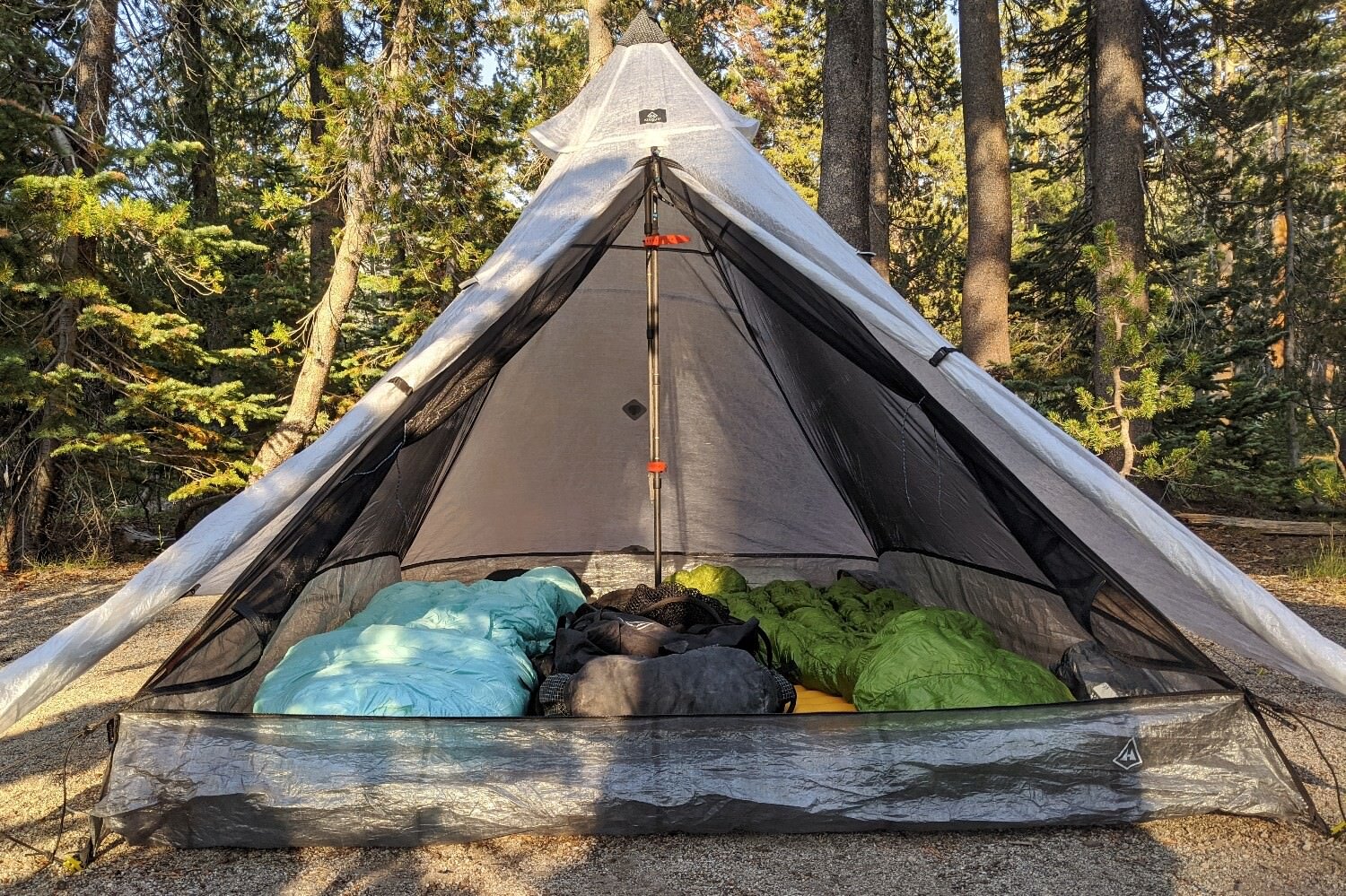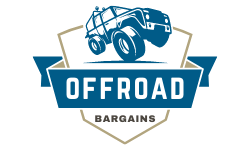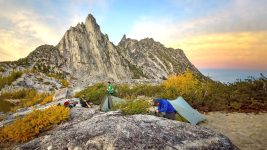
Best Ultralight Tents of 2025, Tested & Reviewed
One of the most effective ways to reduce the weight of your backpack is by choosing an ultralight tent. We compiled research on 64 different options and selected the best models to test, ranging from budget-friendly picks that surprised us to premium fortresses offering storm protection.
We evaluated each model based on various metrics such as comfort, ease of use, and weather resistance, while also keeping in mind the astronomical prices that these shelters often command.
We included both one-person and two-person options to test in the forests of the Midwest. We spent a night in each with the same gear we take on our adventures to see how they fit into a standard backpacking experience and invited friends to evaluate the two-person models.
The lead tester has been an avid backpacker and gear enthusiast for eight years, testing all types of backpacking equipment from deep winter forests to blistering deserts.
And for more info, check out some of our other most popular gear guides:
Quick Picks for Ultralight Tents
Check out this quick list of our favorites, or continue scrolling to see our full list of the best ultralight tents with in-depth reviews.
Best two-person ultralight tent: Durston Gear X-Mid Pro 2+ ($669)
Best one-person ultralight tent: Durston Gear X-Mid Pro 1 ($549)
Best balance of comfort and weight for two: Zpacks Offset Duo ($799)
Best balance of comfort and weight for one: Zpacks Pivot Solo ($649)
Most spacious & weather-worthy ultralight tent: Hyperlite Mountain Gear UltaMid 2 ($1098)
Best low-weight design: Zpacks Duplex Classic ($699)
Easiest to recommend one-person tent: Six Moon Designs Lunar Solo ($260)
Best tent with freestanding option: Tarptent Double Rainbow ($299)
Best budget ultralight tent: 3F UL Gear Lanshan 2 Pro ($190)
Good balance of weight & livability for solo hikers: MSR Freelite 2 ($449)
Best semi-freestanding ultralight tent: Big Agnes Tiger Wall UL2 ($450)
Best versatile tarp net combo: Six Moon Designs Haven ($375)
Best super lightweight one-person silnylon tent: Gossamer Gear The One ($255)
Best super lightweight two-person silnylon tent: Gossamer Gear The Two ($320)
What’s new
Our ultralight tent guide has been completely rewritten! With new research and testing on numerous models, we’re confident we’ve identified the best shelters for keeping your pack weight low.
- There are a few models that carried over from our previous guide and deserve continuing spots on our lineup. The legendary Zpacks Duplex remains a fantastic option, the Lunar Solo continues to be our entry level champion, and the Gossamer Gear The Two, Six Moon Designs Haven, Tarptent Double Rainbow, and Hyperlite Mountain Gear UltaMid 2 remain as well. The Big Agnes Tiger Wall UL2 and MSR FreeLite 2 remain as our ultralight traditional semi-freestanding picks.
- We added many new models to our list. The popular Durston X-Mid Pro 1 and Pro 2+ stunned us with an excellent blend of comfort, weight, and ease of use to earn our editors choice awards for solo and duo adventures. The Zpacks Offset Duo and newly released Pivot Solo were incredible options and the Pivot Solo also earned an Editors Choice award for its unique design and great feature set. The Gossamer Gear The One was also added as a uniquely lightweight silnylon option.
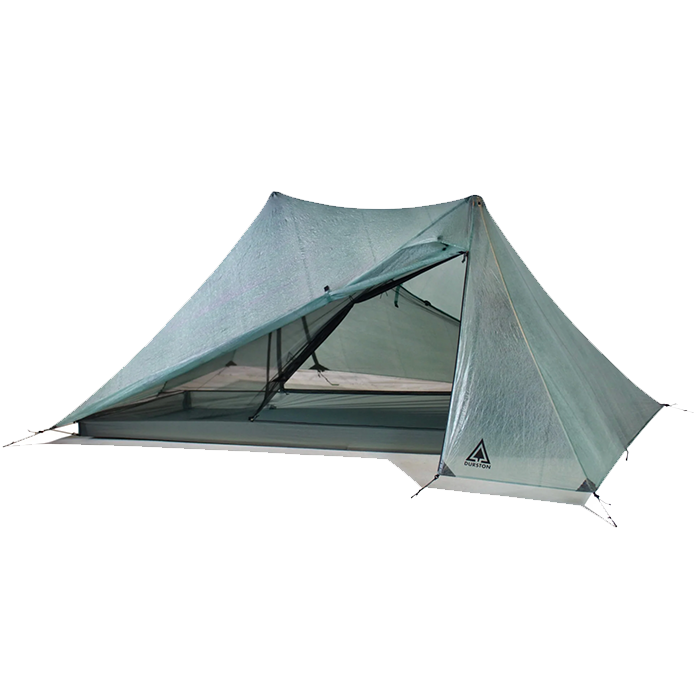
Durston Gear X-Mid Pro 1
Best one-person ultralight tent
CleverHiker Rating:
4.8/5.0
Price:
$549
Weight:
1 lb. 1.4 oz.
Dimensions (LxWxH):
90 x 32 x 45 in.
Floor Area:
20 sq ft
Pros
- Easy to use
- Great for taller people
- Stormworthy design
- Wonderful interior comfort
- Spacious vestibules
Cons
- Can only fit pack at head/foot end
- Alternate pitches require some work
Out of all the one-person tents we researched and tested, the X-Mid Pro 1 came closest to balancing all the features we care about while still maintaining an incredible weight. While many tents that aim to be jack-of-all-trades end up neither appealing enough in any category nor excelling in any specific area, the Pro 1 somehow manages to pull it off and appeals to nearly every feature category. We tested the Pro 1 over 1,000 miles of the PCT and loved it more with each passing mile.
Starting with weight, we measured the Pro 1 at 17.4 ounces, which isn’t the absolute lightest one-person shelter on the market, but is about average for a DCF one-person shelter. What sets the Pro 1 apart is how complete the rest of its feature package feels while weighing only slightly more than other tents that make compromises in some areas. The interior is long, easily accommodating our 5’11” tester, and even leaving room at the head or foot for a backpack. This is a great shelter for taller folks. However, the width isn’t sufficient to fit a pack next to you while sleeping, but this distinction wasn’t a significant concern for us on the trail. Headroom is also excellent; the offset pole geometry provides a lot of space from front to back, and there’s adequate room side-to-side. We could change shirts while sitting up without brushing the condensation off the walls. The vestibules were perfect for storing our pack and shoes at night, and day after day on the trail, we appreciated their size next to the large and comfortable L-shaped doors. However, this comfort does come with a downside, as the biggest design tradeoff of the Pro 1 is its larger rectangular footprint. We never encountered issues with it, but for more cramped trails, Durston Gear offers an alternate pitching guide that helps significantly reduce footprint size.
But it’s in weather resistance that the Pro 1 shines a bit brighter than its peers. With a fly that extends all the way down to the ground to limit splashback, and an offset dual-peak pyramid style geometry that cuts through the wind, we always felt confident during storms. One aspect that also helps in a storm is easy setup. With only four stakes needed for a secure pitch, this was particularly handy when we were hiking until dark through the rain and needed to set up quickly. Four stakes later, we dashed inside while a hiking companion struggled with more stakes for their tent.
Finally, the price is also on the lower end for a DCF shelter, especially when outfitted with the silnylon floor like we have. It’s still not a budget shelter by any means, but the fact that it offers this much performance and comfort at a lower price than other tents is truly impressive. That’s what made the Pro 1 such a delight to use. Night after night, we never grew tired of setting it up and crawling inside; we loved the cozy space and genuinely looked forward to relaxing inside at the end of a long day. When you’re worn out after a long thru-hiking day and a simple tent brings a smile to your face, that’s a quality piece of gear.
That being said, this is not a magic “best tent ever,” and like all tents, it makes some careful design tradeoffs that might not appeal to you. For our hiking style and preferences, we believe those design tradeoffs are smart, but check out our other one-person tent reviews to see if something else suits your style. It’s no wonder this tent has been gradually climbing in popularity, and we can confirm from our testing that it’s absolutely fantastic and well worth the investment.
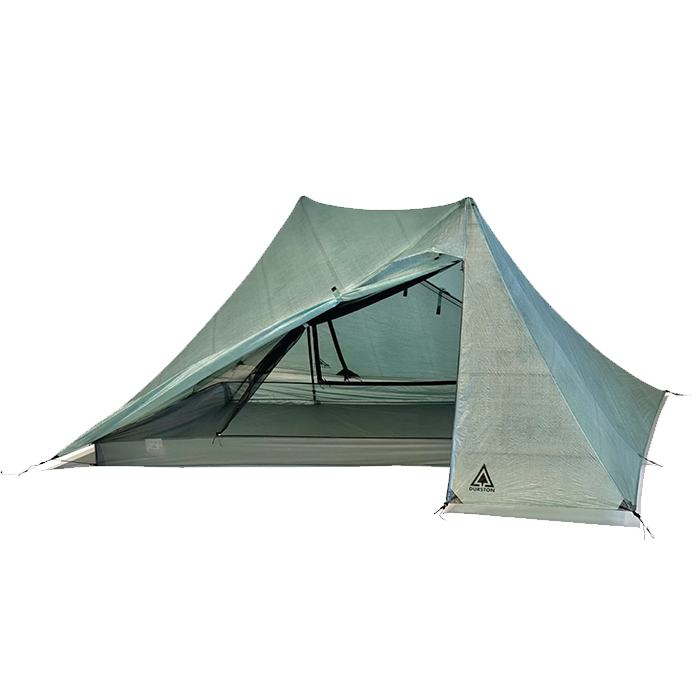
Durston Gear X-Mid Pro 2+
Best two-person ultralight tent
CleverHiker Rating:
4.9/5.0
Price:
$669
Weight:
1 lb. 5.8 oz.
Dimensions (LxWxH):
92 x 52 x 49 in.
Floor Area:
32.5 sq ft
Pros
- Incredible livability for two people
- Easy set-up
- Great ventilation
- Large vestibules
- Large pockets
Cons
- Alternate pitching styles require some work
- Expensive
No other tent does such a good job creating a livable and comfortable experience for backpacking adventures while remaining so lightweight than the Durston Gear X-Mid Pro 2+. With an easy setup, excellent weather resistance, and spacious vestibules, we are left with a tent that impressed us at every turn. If there were one tent we’d want to share with someone on a backpacking adventure, this would be it.
A significant part of the success here is due to the clever design of the offset poles. The two trekking pole locations optimize interior volume more effectively than other configurations. During our first testing of the Pro 2+ in Minnesota on a warm winter afternoon, we laughed with delight upon entering and seeing the spacious interior. Compared to all our other tent options, this one felt the most livable and comfortable. The additional size also ensures that sleeping in any orientation is pleasant. Although the offset pole design creates sloping side walls that may affect headroom for one person sleeping in the same direction, we found it to still be comfortable and not claustrophobic during our tests.
Everything else about the Pro 2+ feels great. The vestibule and door zippers operate smoothly and are well positioned. The doors are large, L-shaped, and are easy to access regardless of your lying orientation. We appreciate that the vents can be easily closed without leaving the tent, and that the vestibules are slightly overhung, preventing rain from falling into the sleeping area when entering or exiting. All these features and comforts do come with some trade-offs. Any luxuriously large two-person tent will have a significant footprint, and the Pro 2+ certainly has one. Durston Gear offers an alternative pitching guide that can drastically reduce the footprint by collapsing the vestibules, which is a thoughtful touch we appreciate from companies. And of course, this is not a budget tent; it’s expensive no matter how you justify it. However, within its class, it stands out as more affordable than its competitors while delivering a better experience, creating a compelling combination that’s hard to resist.
The X-Mid Pro 2+ may not be the best tent for everyone, but among all the ones we tested, it’s the one we feel most confident recommending for two people seeking comfort on the trail at an incredible weight. We left our experience with it utterly delighted and can’t wait for our next adventure together.
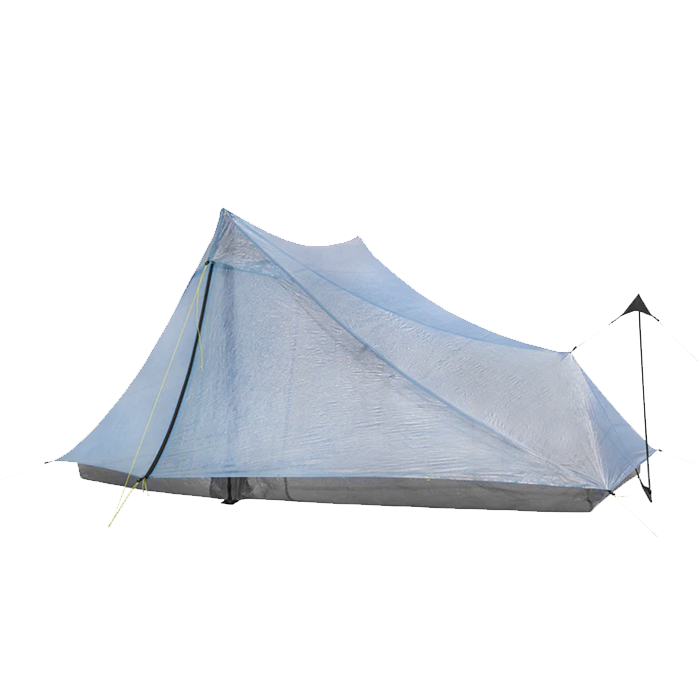
Zpacks Offset Duo
Best balance of comfort and weight for two
CleverHiker Rating:
4.7/5.0
Price:
$799
Weight:
1 lb. 5.1 oz.
Dimensions (LxWxH):
94 x 50/44 x 48 in.
Floor Area:
31.4 sq ft
Pros
- Great interior space
- Super lightweight
- Good vent designs
- Clever panel pull design
Cons
- Higher rainfly perimeter height than competing tents
- Expensive
Traditionally, ultralight tents have been small and minimal to achieve the lightest weights, but the Offset Duo defies convention and asks, “How much comfort can you get for an extra ounce?” It turns out, a lot—an incredible amount, which made us fall in love with the Offset Duo. To be more direct, it’s hard to discuss this tent without mentioning its legendary cousin, the Duplex, which is possibly the most popular thru-hiking tent. For just one extra ounce, the Offset Duo makes key design changes that we believe make it a better option for users compared to the classic Duplex.
Building on the A-frame design, the Offset Duo shifts the poles to one side as its name implies, offsetting the interior peak slightly. This allows for a transition from rainbow doors to more comfortable L-shaped ones, significantly increasing interior headroom. To compensate for the reduced foot end, Zpacks embraces the idea of panel pulls and incorporates one fundamentally into the design, breaking the large front panel into four smaller ones that converge on a sturdy panel pull. You can use a third trekking pole or the included carbon fiber pole here, enhancing livability inside immensely. The interior dimensions are also upgraded from those of the Duplex, and due to the more vertical side walls, that extra space is genuinely usable.
When testing this tent alongside other shelters in various local parks in Minnesota, we consistently returned to it after trying more traditional A-frame shelters because its design felt far more innovative. Most users of the shelter are likely to be in pairs, making the permanent panel pole a smart choice. Additionally, switching to water-resistant zippers is a great enhancement and the fact that the vestibules sit closer to the ground helps protect against splashback and drafts. To ensure durability, Zpacks utilizes the same trail-validated materials found in many of their other shelters, using 0.55 and 1.0 oz/sqyd DCF for the rain fly and floor.
Overall, we believe this is an exceptionally solid shelter, easily one of the best for thru-hiking. If you consider the option of trading an ounce for a significant boost in livability to be worthwhile—as we do—then the Offset Duo should be at the top of your list for consideration.

Zpacks Pivot Solo
Best balance of comfort and weight for one
CleverHiker Rating:
4.7/5.0
Price:
$649
Weight:
1 lb. .1 oz.
Dimensions (LxWxH):
84 x 29/42/28 x 52 in.
Floor Area:
21 sq ft
Pros
- Good floorspace
- Large peak vent
- No wet footbox concerns
Cons
- Tricky initial setup
- Small interior pocket
As the newest tent in our lineup, we believe Zpacks has another hit with the Pivot Solo. With an innovative design that addresses many weaknesses of other one-person shelters, the Pivot Solo has very few downsides and should appeal to a wide audience.
Like all Zpacks tents, the Pivot Solo is made from Dyneema Composite Fiber (DCF) fabric. As a waterproof and low-stretch material, it’s excellent for shelters, and we think this new design will perform well in storms. When positioned with the foot end facing into the wind, the Pivot Solo presents a good profile that should deflect wind effectively. We haven’t tested it in any storms yet, but similar pyramid-style designs have performed well in the past, so we’re hopeful about this design too. The peak vent is large and held open by a peak guyline, which we find to be a great feature as it avoids the stiff brim commonly found on other tents. The door features a smooth, water-resistant zipper leading to a spacious vestibule. It’s here that the Pivot Solo makes a design choice that may divide opinions. The rainfly stops a few inches above the ground, which is beneficial for ventilation, but it compromises splashback performance and can feel drafty. While the large peak vent helps manage condensation, we would have preferred if the fly extended closer to the ground; however, this is a matter of personal preference, and some people will appreciate this choice.
Inside, there’s more good news with plenty of comfort. What excited us most during testing was the small mesh panel at the foot end, made possible by the short vertical pole. It completely eliminates concerns about a wet footbox, providing great peace of mind. The length was also ideal for our 5’11” frame. While there’s not space above or below for a backpack, there’s room to the side, which is great to see. The headroom is mostly good, and the single tall peak enhances overall livability, better than single-pole pyramid tents. One downside is the single mesh pocket; it’s small, angled, and not spacious enough for anything larger than a phone or headlamp, but that might suffice for some users.
The price may also be too high for some, as it’s one of the most expensive one-person tents we considered. However, you’re getting a pretty complete package with very few downsides for that price, so we believe it would be a worthwhile investment for a thru-hike. That’s the overall sentiment we have about the Pivot Solo. If you appreciate how Zpacks addressed certain issues with one-person tents, we think this will make many thru-hikers very happy.
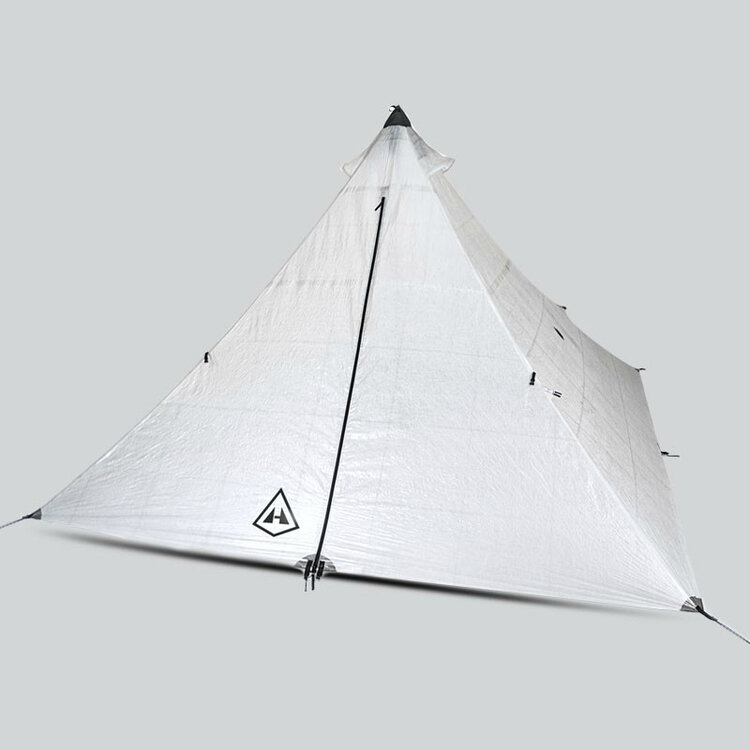
Hyperlite Mountain Gear UltaMid 2 with Full DCF Inner
Most spacious & weather-worthy ultralight tent
CleverHiker Rating:
4.7/5.0
Price:
$1,098
Weight:
2 lb. 8.7 oz.
Dimensions (LxWxH):
96 x 76 x 64 in.
Floor Area:
50 sq ft
Pros
- Incredible weather resistance
- Huge peak height
- Great floor space
Cons
- Expensive
- No vestibule
- Interior pole is in the middle of the floor
For the best weather resistance of any tent we’ve tested, the Ultamid 2 stands far ahead of the competition, practically in another class of tents. However, all that performance comes with significant trade-offs in other areas that may not make it worthwhile for most backpackers.
Starting with the positives, the Ultamid 2 features a pyramidal shape that excels at deflecting wind from nearly any direction. Combined with ample staking points and guylines, and with some appropriate setup time, this can become a storm fortress capable of withstanding more extreme conditions than other backpacking shelters. The materials are correspondingly sturdy to endure high winds. The rainfly is made from 0.8 oz/sq yd DCF, an incredibly strong material, and the stitching quality is excellent as well. To achieve a pyramid shape with a spacious interior of 50 square feet, the Ultamid 2 boasts a peak height of 64 inches, the tallest in our lineup, effectively eliminating the claustrophobic feelings typical of smaller shelters.
However, focusing so heavily on one area entails trade-offs, and as we mentioned, the Ultamid 2 is nearly in a different class of tents. For starters, it’s heavy. Weighing in at 40.7 ounces, this is the heaviest tent in our lineup due to the more durable fabrics and components. Although its large dimensions seem appealing on paper, in practice they result in a shelter that isn’t as comfortable as the numbers imply. The sloping walls, which are effective at shedding wind, quickly limit headroom. Although our sleeping quilts did not touch the walls, they easily brushed against the inner mesh. Without a vestibule, entering and exiting exposes the interior to rain, and the tall central pole, made of two lashed trekking poles, makes getting close to your sleeping partner much more challenging.
That’s before considering the price. This is the most expensive tent we tested by a considerable margin. So, for more weight, a higher cost, and less comfort than many other tents we evaluated, does this even make sense? Well, yes; it’s simply in a different class of tents. This isn’t meant for casual or even moderately intense backpacking; it’s designed for adventures that push the limits of weather resistance. For those individuals, 40.7 ounces is an impressive weight, and the price is justifiable for the performance at this weight. While we weren’t able to test this tent to its full potential during a mild Midwestern winter, we’re confident it will live up to its stellar reputation.
More:
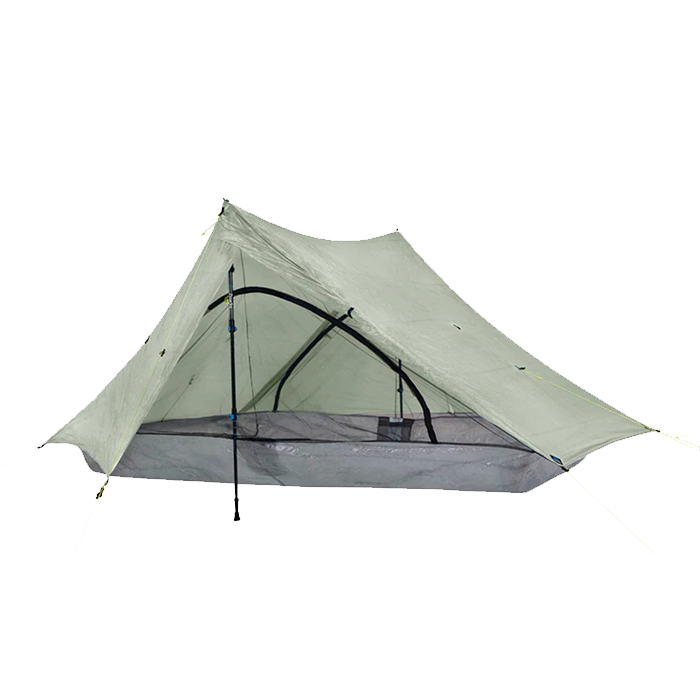
Zpacks Duplex Classic
Best low-weight design
CleverHiker Rating:
4.6/5.0
Price:
$699
Weight:
1 lb. 1.9 oz.
Dimensions (LxWxH):
90 x 45 x 48 in.
Floor Area:
28.1 sq ft
Pros
- Amazing weight for a 2p shelter
- Simple setup for a trekking pole shelter
- DCF material doesn’t absorb water
Cons
- Cramped for 2 people
- Rainbow doors are love/hate
- Average weather resistance
One of the most popular backpacking tents continues to impress as one of the lightest two-person tents available. We measured it at just 18.5 ounces, which is lighter than most traditional one-person tents. Zpacks has a winner here, but they may have surpassed themselves in product innovation, as we believe other models in their lineup enhance the qualities that make the Duplex Classic so appealing.
Before we dive into that, let’s discuss the positives. First, the Duplex is remarkably light for a two-person tent. Featuring two large doors and vestibules on either side, the weight per person when shared is an incredible 9.25 ounces each. The brilliance of this design lies in its simplicity. There are no rainfly zippers, no tent poles, no double-wall construction, and just enough space for two.
However, most backpackers tend to use this tent as a solo retreat. For that purpose, it’s still an excellent choice, though it comes with a significant footprint for one person. Moreover, the weather resistance leaves something to be desired. With large fabric panels that catch the wind and a high perimeter rainfly that doesn’t guard against splashback, the Duplex isn’t our top pick for stormy conditions. That said, it performs adequately for most backpacking scenarios, and as a bonus, the DCF material doesn’t sag when wet and dries quickly. Nevertheless, Zpacks has continued to innovate and has addressed some shortcomings of the Duplex with the much more spacious Offset Duo.
For weight purists, however, the Duplex’s numbers are undeniable. It remains a premium tent, but its popularity indicates that many people view it as a worthwhile investment for a thru-hike.
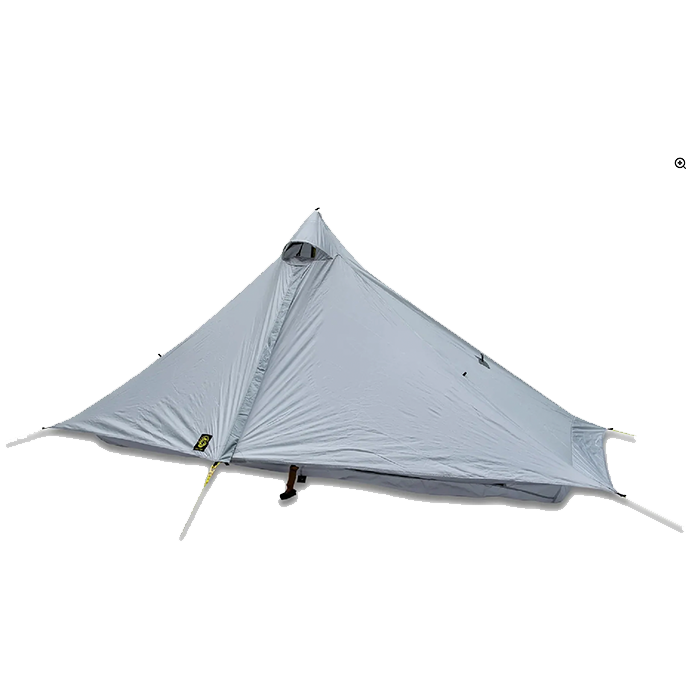
Six Moon Designs Lunar Solo
Easiest to recommend one-person tent
CleverHiker Rating:
4.6/5.0
Price:
$260
Weight:
1 lb. 10 oz.
Dimensions (LxWxH):
90 x 48 x 49 in.
Floor Area:
26.3 sq ft
Pros
- Excellent performance for price
- Spacious interior floor space
- Silpoly fabric won’t sag when wet
- Good weather resistance
Cons
- Pyramid design limits headroom
- Tricky setup to get a great pitch
The Lunar Solo is one of those tents that’s truly easy to recommend. Without knowing much about someone’s backpacking style, we frequently suggest this high-performing shelter when people ask which tent they should buy. And for good reason. It excels in the essentials of backpacking tents in a way that appeals to a wide range of both experienced and novice backpackers.
Firstly, it offers a fantastic price and weight. Weighing in at 26.1 ounces on our scale, that’s a weight that should please traditional backpackers and garner a nod of approval from ultralight enthusiasts. It also provides a surprisingly large amount of space for one person, easily accommodating our gear to the side. It’s even spacious enough to serve as a two-person tent in a pinch! Plus, the silpoly fabric won’t sag when wet in the rain, ensuring that your pitch stays tight throughout the night.
However, that pitch is one of the downsides. With its hexagonal shape, we found the Lunar Solo more complicated than most for achieving a great pitch. It’s definitely easy to set it up and make it look nice, but when we’re weathering a storm, we need it tight and secure all around—something we struggled with on the Lunar Solo. This aspect tends to improve with experience across all tents, but it’s worth mentioning here. The single-wall design combined with a sloping pyramid shape also means that it’s easy to brush against the walls in wet conditions.
Despite these drawbacks, the Lunar Solo still delivers an impressive performance-to-price ratio, which has made it incredibly popular for good reason. It’s one of the easiest shelters to recommend for this reason, and we believe it will continue to impress outdoor enthusiasts for years to come.
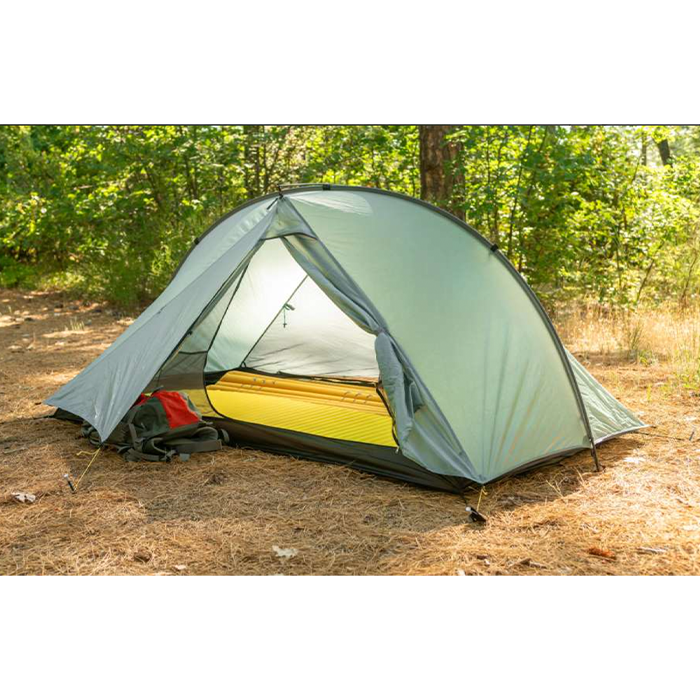
Tarptent Double Rainbow
Best tent with freestanding option
CleverHiker Rating:
4.6/5.0
Price:
$299
Weight:
2 lb. 4.5 oz.
Dimensions (LxWxH):
88 x 50 x 42 in.
Floor Area:
30.6 sq ft
Pros
- Excellent weight for non trekking pole design
- Good length for taller people
- Solid magnetic door closure
- Freestanding with trekking poles
- Fun porch mode
Cons
- Limited lateral head room
- Pole removal from sleeve is tricky
Among ultralight shelters, the Tarptent Double Rainbow is renowned for its comfort, versatility, and affordability for hikers, and we can attest to its stellar reputation; this tent truly excels. Its unique design utilizes a single curved pole running down the spine, creating near-vertical walls at both the head and foot ends, allowing you to take full advantage of the 88 inches of length. This design also provides decent wind resistance, and the two guyline attachment points midway up the pole structure should ensure solid performance in storms.
Inside, we appreciated the thoughtful design choices. Large pockets on either side are ideal for storing your phone and charger at night, while the ceiling features mitten hooks for an optional liner accessory or for stringing a clothesline to dry gear. One downside is the limited lateral headroom when sitting up; although we find it acceptable, other shelters in this price range offer a better experience.
However, the standout feature is the ability to convert to freestanding mode. By using two trekking poles horizontally to connect the corners, the entire tent can become freestanding. This is a fantastic benefit for hikers on trails where tent platforms are common (like the Appalachian Trail) or for those who prefer not to search for heavy rocks to secure the corners on poor soil. Additionally, there’s a fabric piece tucked between the doors that can be stretched across when open to create an awning; this is perfect for waiting out light rain and helps the tent feel less claustrophobic.
The price and weight of the Double Rainbow are both competitive, especially given its potential to become a freestanding tent. It is priced significantly lower than premium semi-freestanding models yet weighs only slightly more while offering enhanced livability. Depending on your priorities, the Double Rainbow could strike the ideal balance of features and value.
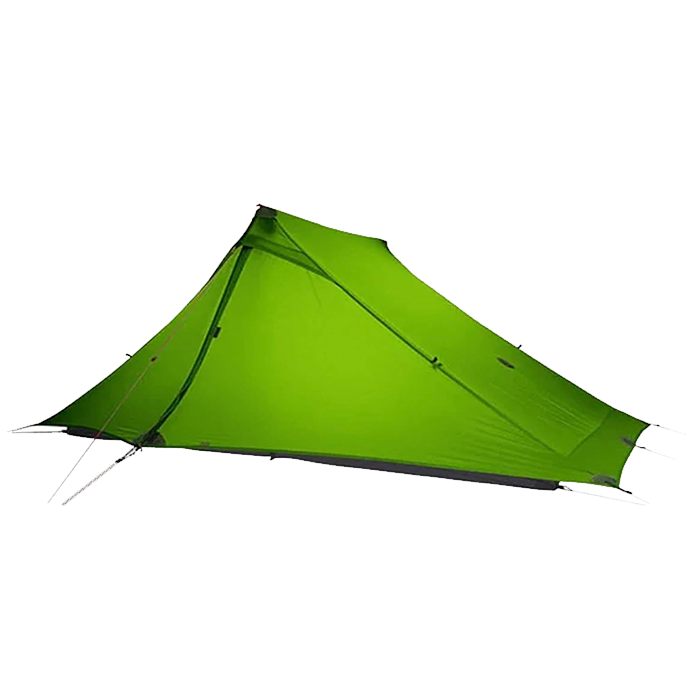
3F UL Gear Lanshan 2 Pro
Best budget ultralight tent
CleverHiker Rating:
4.6/5.0
Price:
$190
Weight:
2 lb. .3 oz.
Dimensions (LxWxH):
106 x 47 x 49 in.
Floor Area:
29.7 sq ft
Pros
- Good livability
- Easy to pitch
- Excellent included stakes
Cons
- Cheap feeling fabric
- Cumbersome vent design
- Only one pocket
No other tent provides this level of performance at such an affordable price. Previously, those seeking an inexpensive ultralight option needed to master tarp setups and adjust to using bug head nets for sleeping. However, the Lanshan 2 Pro demonstrates how much budget ultralight shelters have evolved and the great value you can receive for your investment.
First and foremost, we’re pleased to report that the Lanshan offers decent comfort. It’s not a palace, but we encountered no issues, even with individuals standing at 5’11” when sitting up or lying down. We managed to fit two lofty three-season quilts and sleeping pads inside without feeling at risk of contacting the side walls with our footbox or head. Although it retains the classic A-frame design, which causes the side walls to slope inward, limiting floor space, the generous dimensions meant this wasn’t a significant problem for us. On a positive note, we appreciated the versatile door design that allows either side to open, or both at once.
That said, this is still a budget-friendly tent, which means there are some compromises. The durability of the fabric remains uncertain, a skepticism that simply comes with the budget category. It feels somewhat different from the silnylon we’re accustomed to, but different doesn’t necessarily equate to inferior, and only long-term testing will yield answers. For now, we remain cautiously optimistic; besides an unusual hand feel, it doesn’t appear significantly inferior. The vents pose another concern. The rigid fabric that keeps them open is cumbersome when rolling up the tent. While we value the size of the vents, the brim design feels unnecessarily complicated.
Yet, overall, we genuinely liked this tent more than we anticipated, to the extent that we wouldn’t hesitate to take it on our next big adventure. Its weight is even lighter than some of its counterparts, and its unbeatable price makes it a genuinely appealing option. If you’re new to ultralight camping and feel hesitant about the higher prices, we believe the Lanshan 2 Pro is an excellent starting point.

MSR Freelite 2
Good balance of weight & livability for solo hikers
CleverHiker Rating:
4.3/5.0
Price:
$449
Weight:
2 lb. .1 oz.
Dimensions (LxWxH):
84 x 50 x 39 in.
Floor Area:
29 sq ft
Pros
- Roomy for one
- Two doors/vestibules (a perk for solo hikers)
- Convenient pockets
- Rainfly gutter prevents drippy entry
The MSR FreeLite 2 is a great option for those looking to go lighter without sacrificing the convenience of a double-wall tent. It has two large doors/vestibules, a smart rainfly design that prevents drippy entry in the rain, and a lower weight than many similarly designed tents.
We view the FreeLite as more comfortable for solo hikers since the interior headroom can feel a little cramped when spending any extended amount of time inside. But for pairs that value saving weight over having more interior space, the FreeLite has the dimensions to accommodate two people.
The rainbow shape of the FreeLite is effective at shedding precipitation, and the unique rainfly gutters direct water away from the zippered entry to prevent it from pooling up and pouring onto the floor while moving in or out of the tent in wet weather.
Solo backpackers wanting the best mix of weight, livability, and weather protection will love the FreeLite, and pairs who would opt to save weight and don’t mind tight quarters will find that this tent delivers excellent performance.

Big Agnes Tiger Wall UL2
Best semi-freestanding ultralight tent
CleverHiker Rating:
4.2/5.0
Price:
$$450
Weight:
2 lb. 3 oz.
Dimensions (LxWxH):
86 x 52/42 x 39 in.
Floor Area:
28 sq ft
Pros
- Very light for a pole tent
- Amazing gear storage pocket
- Quality construction
Cons
- Tight for two people
- Poor door design
For a traditional pole tent, it’s hard to find a lighter option with two doors and two vestibules than the Tiger Wall UL2. Weighing in at a shocking 35 ounces, it has proven to be a consistently popular choice on many long-distance trails.
Like many Big Agnes tents, the Tiger Wall feels like a quality piece of gear; every component is high quality and well made, even if the materials are thin. Setting it up is easy and straightforward, though, like all semi-freestanding designs, staking is necessary to ensure a fully secure shelter. The interior also sports a wonderful gear storage pocket at the front end, a frankly enormous amount of mesh that’s perfect for stuffing a puffy jacket, damp socks, or even an entire sleeping quilt in a pinch.
However, there’s not a ton of room on the inside. Like a lot of two person tents in this class, it’s frequently used as a one-person tent since two people can feel cramped. It’s not terribly uncomfortable for two, though. During an adventure in the Boundary Waters, when another tent proved to be less mouse-proof than expected, we squeezed two people into the interior without issue, and both found the experience more comfortable than expected. However, for longer thru-hikes, the lack of space might be problematic for some, and the larger Tiger Wall UL3 is thankfully a great option for that scenario.
Additionally, the silnylon fabric will sag when wet, and the lightweight nature of this tent doesn’t make it our first choice for stormy weather. Even among other ultralight tents, we’d want to ensure it was properly staked out with guy lines in any high winds. The door design also disappointed us, limiting headroom when entering and exiting, a situation made even worse in the rain. All these details, coupled with the relatively high price, make it a tougher sell today than it was years ago, especially with stiff competition from trekking pole tents.
However, for backpackers seeking a lightweight pole tent, the Tiger Wall UL2 remains a great shelter that should keep hikers happy for many years to come.
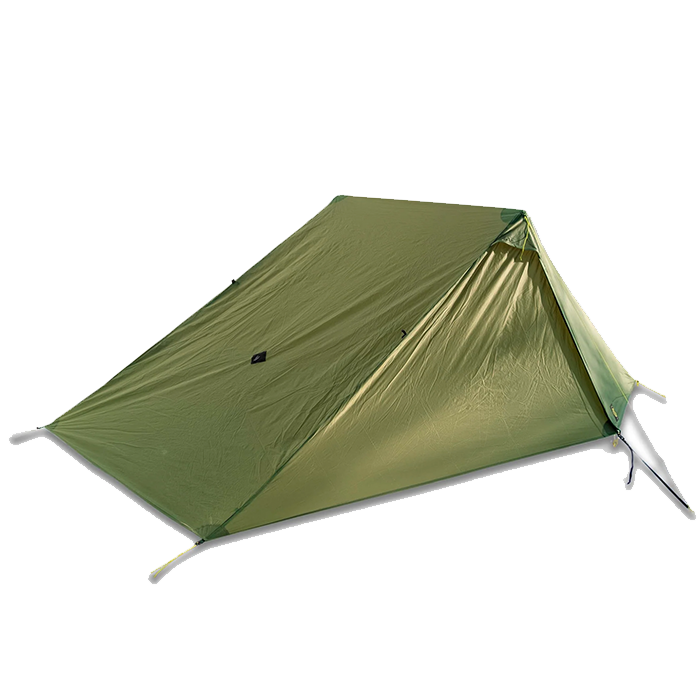
Six Moon Designs Haven
Best versatile tarp net combo
CleverHiker Rating:
3.9/5.0
Price:
$375
Weight:
2 lb. .12 oz.
Dimensions (LxWxH):
88 x 44 x 45 in.
Floor Area:
27 sq ft
Pros
- Modular design
- Durable materials
- Lightweight
Cons
- Small interior
- Difficult pitching with net
- Small pockets
The Haven offers a unique proposition for backpackers in search of a double wall shelter. Although it doesn’t quite hit the mark, it still stands as a tent that should satisfy many adventurers. For starters, it uses an offset double wall A-frame design. This design provides more headroom than a symmetrical design would, but also cuts down on room for the footbox of the quilt. With the supporting trekking poles positioned farther back, large L-shaped doors are possible, which we found to be comfortable and spacious.
Inside, we had mixed feelings about livability. While we managed to fit two lofty quilts and sleeping pads without any issues, we noticed there wasn’t a lot of extra room for individuals around six feet tall. It’s acceptable, but the way the inner net tent connects to a single point in the fabric panel causes the mesh to hang uncomfortably close to our faces. Simultaneously, the footbox of our quilts didn’t touch the sidewalls, but it wasn’t positioned at a comfortable distance either. Your experience may vary, as everyone has different comfort levels; for us, it’s acceptable but not beyond that. The large fabric panels also do not instill great confidence in their weather resistance. Even with the panel pulls, this wouldn’t be our top choice of shelter during storms.
One of the biggest advantages of the Haven is its double wall design. The ability to leave the net tent at home allows for significant weight savings or excellent stargazing opportunities by removing the tarp. The net tent attaches to the tarp at four corners and two panel pulls, but we believe the attachment at the peaks isn’t the best design. The net tent has two small pockets of durable fabric for the trekking pole tips that rest against the peak of the rainfly. However, there is no attachment to the rainfly, which results in the net tent moving around more than we’d prefer during setup. It also requires more precision in the setup process than quickly inserting trekking poles handle-up, as is common with other tents of this style.
Lastly, there’s a price to consider. It’s pricier than other trekking pole shelters, but for those who genuinely desire a double wall design, the price is reasonable for the quality offered. For someone a tarp and inner net combo for two people and who doesn’t mind the pitching requirements, we believe the Haven could serve as a solid tent for many miles on the trail.
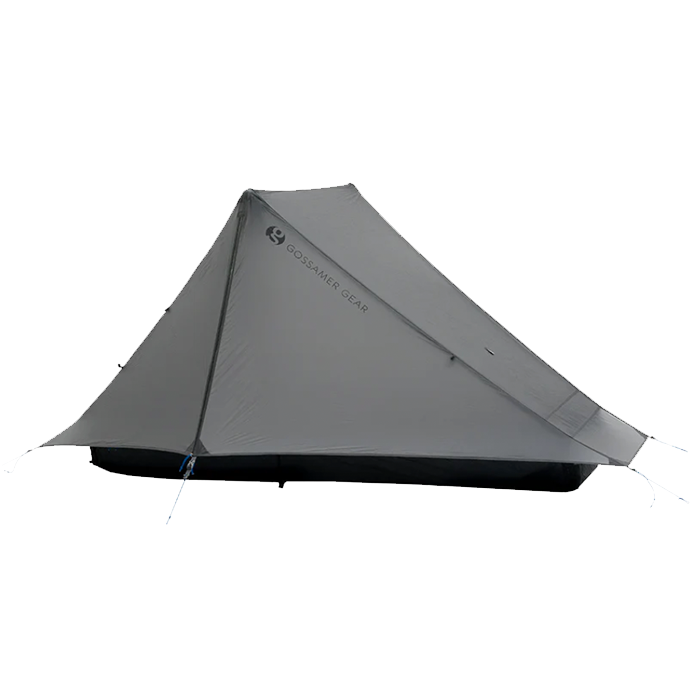
Gossamer Gear The One
Best super lightweight one-person silnylon tent
CleverHiker Rating:
3.8/5.0
Price:
$255
Weight:
1 lb. 3.5 oz.
Dimensions (LxWxH):
84 x 33/21 x 45 in.
Floor Area:
15.8 sq ft
Pros
- Extremely light for a silnylon shelter
- Easy to pitch
- Great headroom
- Huge peak vent
Cons
- Tiny door
- Small interior
- Not great for storms
- Thin materials
There’s one number that stands out above all others about The One, and it’s the frankly ridiculous weight. We measured it at 19.5 ounces. For a fully enclosed silnylon shelter, that’s unparalleled, and for many, it’s a compelling reason to choose this as their next tent. We can cautiously endorse that choice, but it’s important to know that Gossamer Gear designed this tent with some specific tradeoffs to achieve that weight.
The most significant tradeoff is the material choice. Utilizing 10d silnylon for both the fly and the floor explains much about why this tent is so light. Other ultralight shelters typically use at least 15d and often 20d to 40d, meaning extra care is required here. For many ultralight backpackers accustomed to high maintenance routines, this might not be a major issue. The second significant tradeoff is comfort, though it’s not entirely negative. We’ll begin with the biggest advantage: the expansive headroom provided by the two trekking poles. Side to side, it’s generous, and the 45-inch height means it’s decent front to back as well. However, the interior space quickly feels cramped when considering the floor area. With only 15.8 square feet of space, it’s evident that Gossamer Gear didn’t intend for this to offer a lot of extra room. Our 5’11” tester encountered issues with headroom and footbox space. Although the large peak vent helps with condensation, humid mornings can sometimes make it unavoidable. Without much room to spare, a wet footbox is more concerning here than with other tents.
Finally, this is not a tent designed to withstand severe storms. The lightweight materials give us reason to pause, but it’s the design of the half vestibule on one side that really concerns us. Exposing the vertical side walls means that if the wind shifts direction and hits this tent broadside, it won’t hold up well. Nevertheless, this is yet another design tradeoff that we believe Gossamer Gear fully recognizes. This tent isn’t meant for harsh storms, but it will keep you completely dry during typical rainstorms.
In the end, The One is a tent that involves more tradeoffs than most, yet we found ourselves agreeing with many of the choices as we considered the target niche. It’s suited for someone who primarily enjoys fair-weather backpacking but desires moderate protection from occasional rain. This person won’t mind a small interior, will accept the extra care required for 10d fabric, and appreciates the benefit of headroom. All this comes at a remarkably light weight and price. Most comparably light shelters are twice the cost, although it’s important to note that they come with significantly fewer compromises in other areas. So, if you’re one of those individuals who nods in agreement with all these tradeoffs, we believe The One will delight you. It’s truly unique in its offerings and should bring satisfaction to that niche of users.
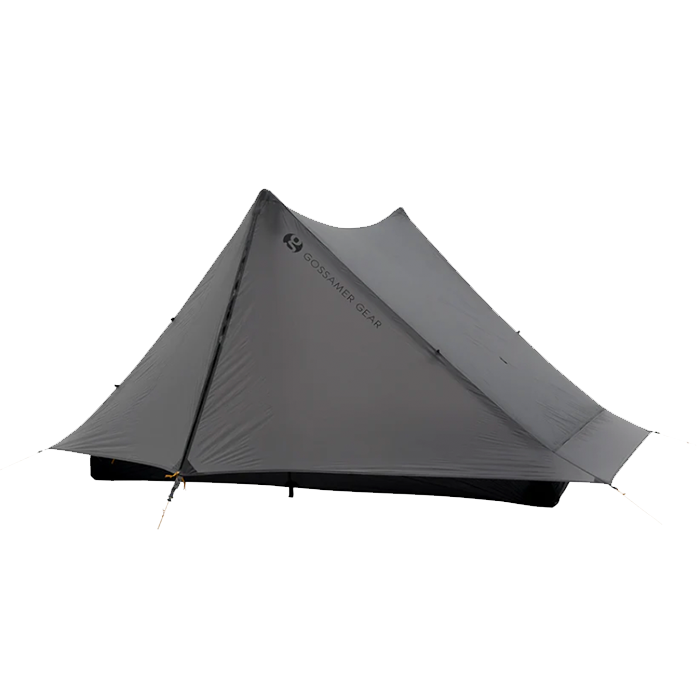
Gossamer Gear The Two
Best super lightweight two-person silnylon tent
CleverHiker Rating:
3.6/5.0
Price:
$320
Weight:
1 lb. 9.3 oz.
Dimensions (LxWxH):
84 x 48/42 x 43 in.
Floor Area:
26 sq ft
Pros
- Extremely lightweight for a silnylon shelter
- Easy set-up
- ood pockets
Cons
- Small interior
- No vents
- Thin materials
Gossamer Gear has made something both special and quite specialized with The Two, offering an incredible weight for a silnylon backpacking shelter. At just 25.3 ounces when we weighed it, such weights are typically achievable only with much more expensive DCF. For a two-person shelter, that’s impressive, but it brings some significant design trade-offs that indicate Gossamer Gear is focused on crafting a tent for a specific type of person who will love it, rather than a tent for everyone. And we can’t fault them for it; The Two excels in its niche.
There are two factors that contribute to the incredible weight here: a smaller A-frame design using trekking poles and super thin 10d silnylon for both the rainfly and floor. Right away, that signals this is a shelter for someone who takes extra care with their gear and understands how to ensure the fabric lasts many nights of use. When first setting up The Two in a local park in the Midwest on a warm winter’s day, the thin fabric was immediately noticeable. But thankfully, it feels just as high quality as other nylons we’ve used, albeit thinner. That fabric choice also enables another neat feature—packing smaller than other tents, especially those made of DCF.
The smaller A-frame design results in a compact interior. Compared to its peers, The Two offers only 26 square feet of floor space, which is nearly the same as some of the larger one-person tents we reviewed! In practice, it feels tight. Not unbearably so, but if you’re near six feet tall, be prepared to gamble either with limited headroom or a wet footbox. This leads us to another design choice made to save weight: there’s no ventilation. The large doors and vestibules help mitigate this on clear nights, but this design will accumulate more condensation than other tents.
When the weather turns stormy enough to close those doors, The Two will also struggle. Since it’s wider than other A-frame style tents, it exposes a substantial amount of flat area to the wind, making it a sail in storms. We’ve had personal experience with this, witnessing one get flattened in a surprise thunderstorm that rolled through the Swiss Alps. That storm also collapsed a few other tents, so The Two wasn’t alone in its fate, but a sturdier trekking pole tent and one freestanding tent managed to survive.
However, for the right person, these design trade-offs are worthwhile for the essentials: an unbelievable weight at a reasonable price. The Two occupies a unique position among ultralight tents, carving out a niche as a specialized shelter. If the downsides don’t bother you, we believe it’s a great option that will enable a very lightweight pack on the trail.
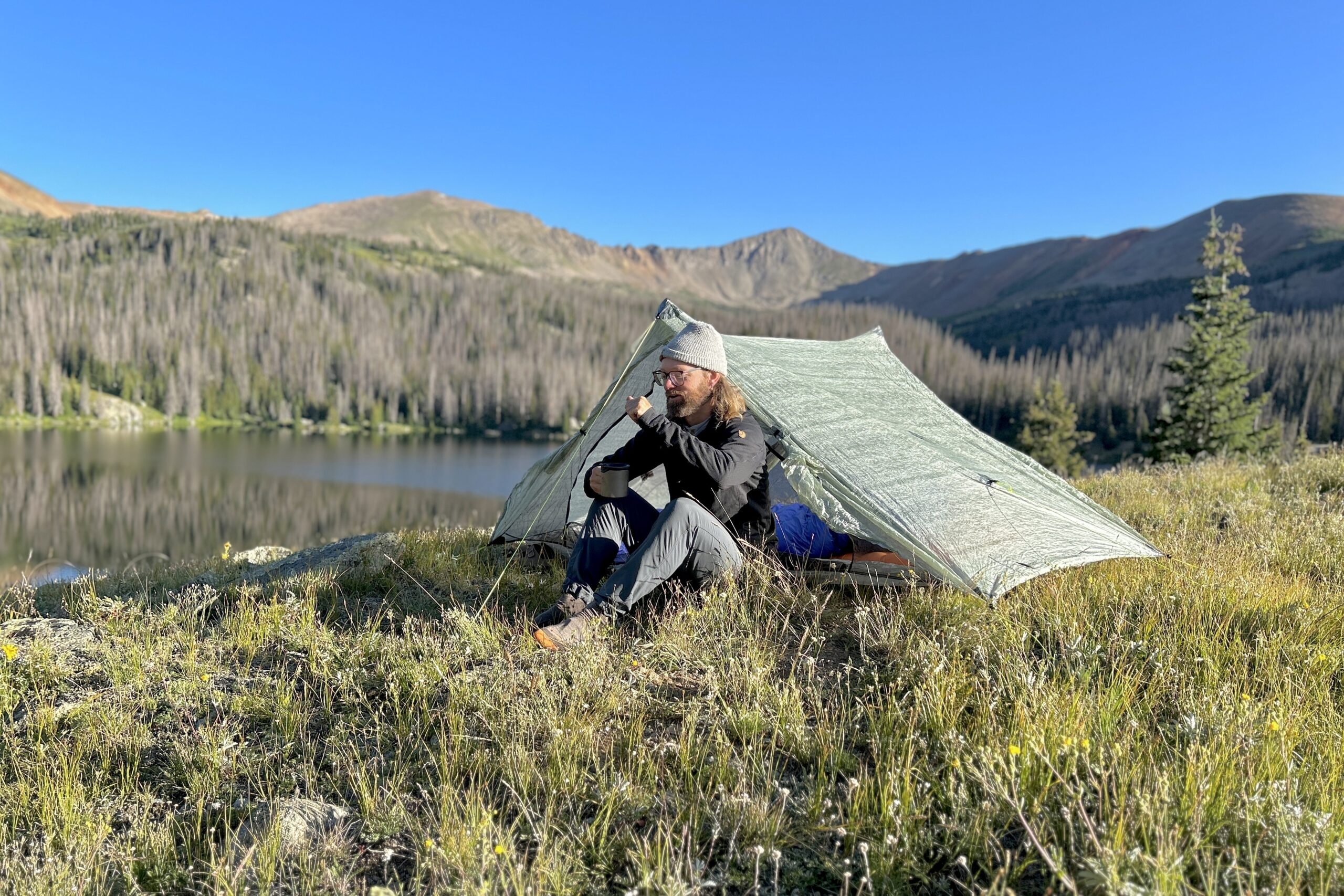
How We Test
COMFORT
Staying comfortable on the trail is important to get the most out of your hike, whether it’s an overnight trip or a multi-month adventure. To evaluate comfort for tents, we used a representative gear loadout for a typical backpacking setup. This included a 20-degree quilt and a three-season, 2.5-inch thick sleeping pad. For two-person tents, we added a 30-degree quilt and another 2.5-inch sleeping pad. Our tester is 5’11″, which represents slightly above-average height and covers 80% of men and 90% of women based on American data.
We positioned the footbox as close as we comfortably could to the end wall without worrying about condensation and laid back to evaluate the remaining headroom. We sat up and moved around to check the available headroom both laterally and from side to side, seeing how easily it would be to change clothes or stretch after a long day.
WEIGHT
This ultralight tent guide focuses primarily on weight, as it is a major consideration for many of these tents. We weighed each tent rather than relying on manufacturers’ claims. The weight includes any necessary poles for the tent’s functionality, but we excluded stakes, as they are often a personal choice for many hikers.
EASE OF USE
Some tents can cut corners with ease of use to achieve a lighter weight, although all the tents we tested performed well in this category. We evaluated door size and function, noting which tents were easy to enter and exit. For two-person tents that allow sleeping orientation in either direction, we observed whether the door was difficult to use from one side and if vestibule access was obstructed.
We assessed the accessibility and size of interior pockets, awarding points for fully functional pockets and deducting points for angled designs prone to items falling out. We set up each tent consecutively to compare how each model performed against its peers.
For trekking pole tents, we examined how much adjustment was necessary to achieve a tight pitch and whether the setup process was intuitive and forgiving of mistakes. We reviewed manufacturer instructions for pitching and utilized included stakes to provide as close to a “manufacturer intended” experience as possible.
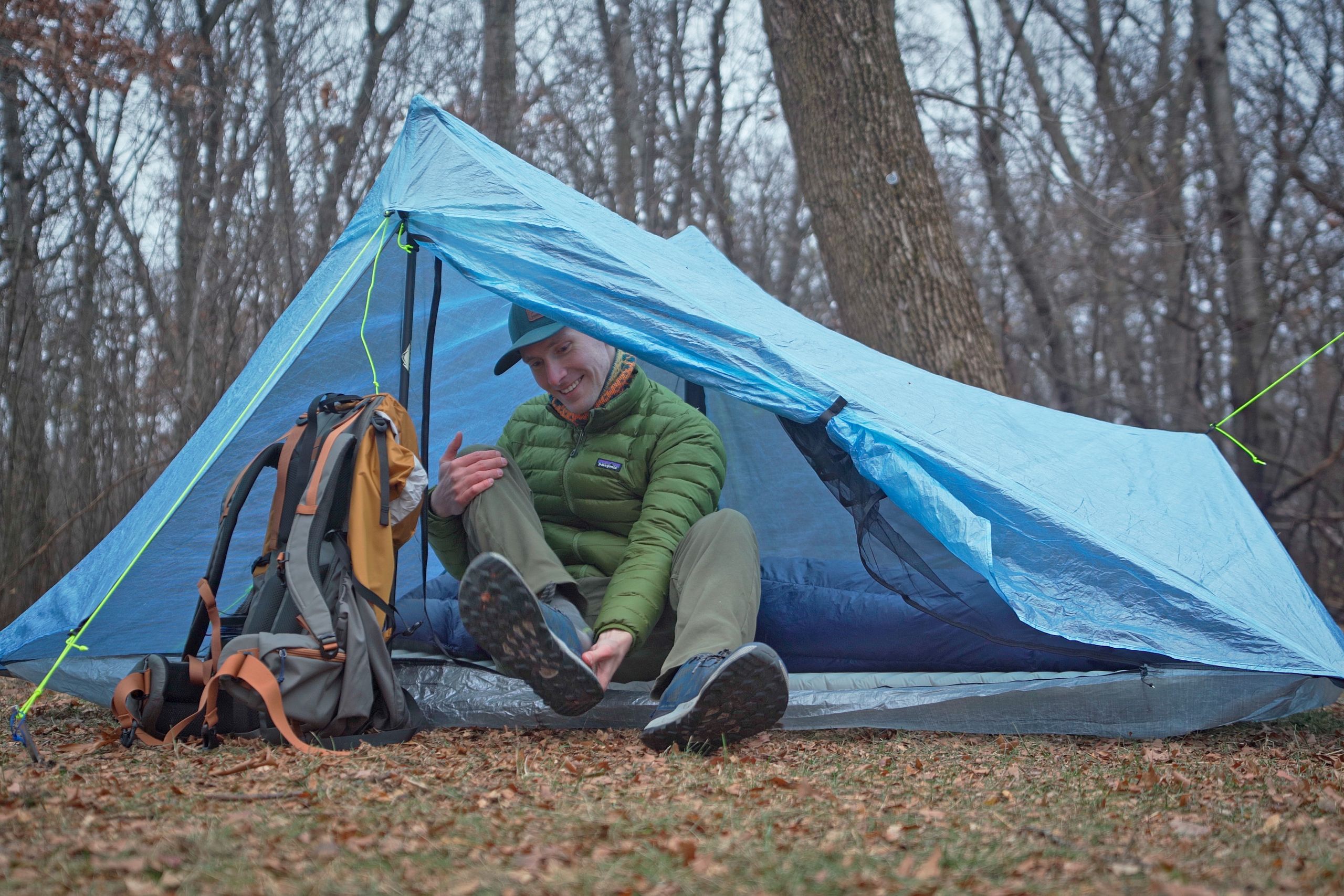
WEATHER RESISTANCE
For this edition of the guide, we didn’t cover firsthand weather resistance since we tested during the colder months, and most of these tents are not rated for winter storms. We’ll update this guide and the corresponding reviews with appropriate storm testing as it evolves.
For a few tents, some testing was conducted on long trails during heavy use, and we’ve included weather resistance findings from those adventures in their respective reviews. Non-experimental findings from the design evaluation of each tent have been included. This includes checking for large panels of exposed fabric that could catch the wind, evaluating rainfly to ground distances for splashback resistance, and examining guy line attachment points for more advanced storm protection.
We noted which orientations each tent would be strongest in the wind and whether they featured any obvious weak orientations that would struggle in a storm.
DURABILITY
An ultralight tent typically comes with the understanding that it may not last as long as other shelters, and we’ve aimed to note which tents are most likely to endure season after season. We closely examined material choices, identifying which ones have been time-tested on trails and which require extra care or a recommendation to use a groundsheet.
Stitching quality and overall manufacturing condition can indicate longevity. We looked for poorly reinforced seams, particularly at high-stress points, and tested them by pulling to see how much the threads stretched.
For all zippers, we noted their size and water resistance, checking the end stops to ensure they were properly reinforced. We also observed the significant differences in fabric hand feel, although without a tensile testing machine, we can’t directly assess tensile strength.
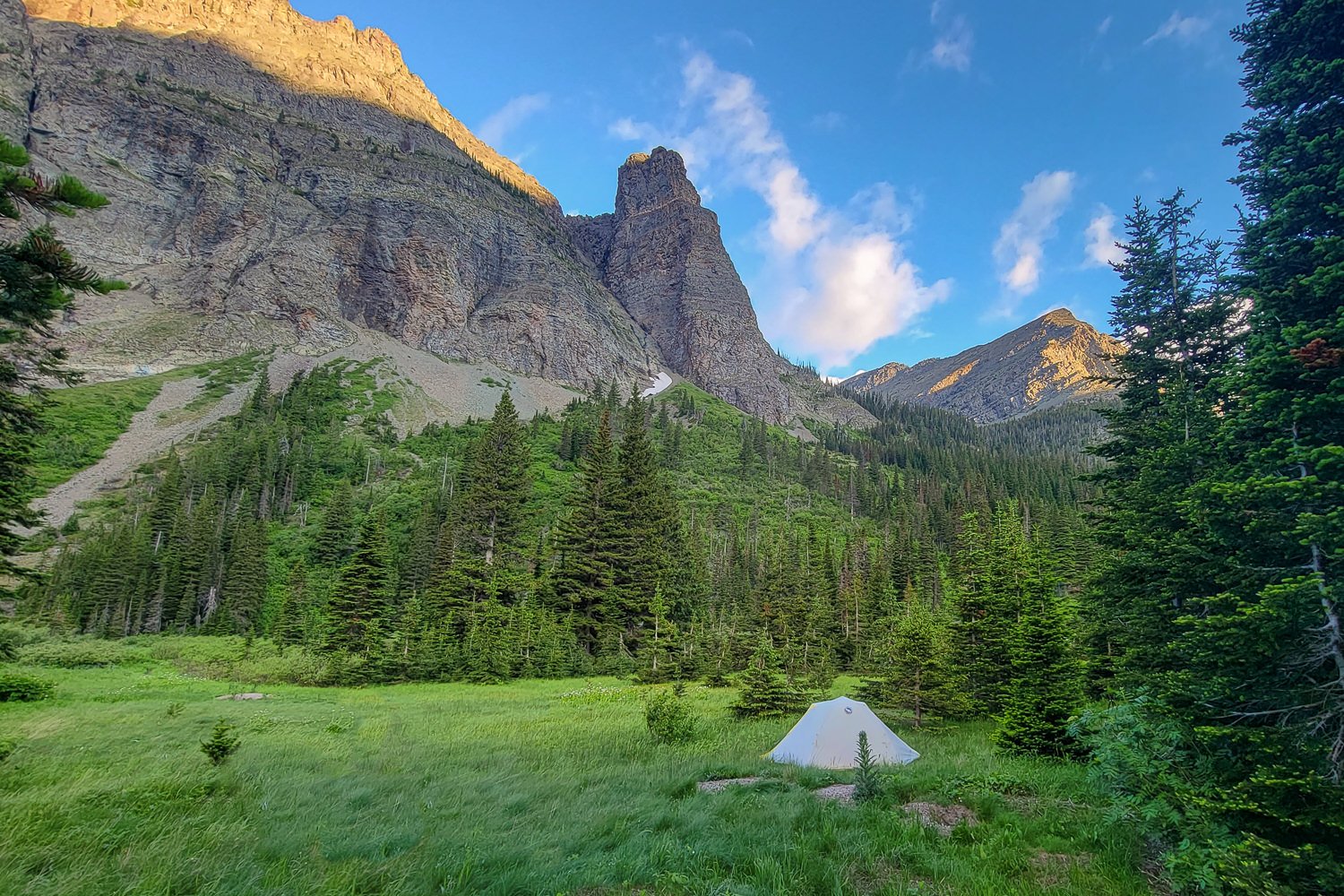
Why Trust CleverHiker
CleverHiker gear analysts have spent over 2,000 nights under the stars, many of which were in ultralight tents. Lead tester Taylor Passofaro has pursued ultralight backpacking adventures for seven years, covering over 3,000 miles in search of beautiful mountains to explore.
He has hiked the Pacific Crest Trail, Superior Hiking Trail, Collegiate Loop, Laugavegur and Fimmvörðuháls trek, the Tour du Mont Blanc, among others, along with countless nights spent in the parks and forests of his native Minnesota. Many of these adventures were specifically to evaluate new tents, gear, or experiences, with each trip contributing to his goal of mentally cataloging every piece of backpacking gear available.
His background in medical device design and test engineering ensures that every gear choice is thoroughly researched (and graphed more times than necessary) before testing, resulting in solid gear recommendations for all types of adventures.
Analysis & Results
VALUE
Ultralight tents are among the most expensive pieces of gear in your backpack. Determining which one is worth your investment can be a tough choice, influenced by your adventure style, comfort priorities, and, of course, your budget. Therefore, the most crucial aspect of selecting gear isn’t reading gear guides or optimizing spreadsheets, but rather developing a deep understanding of what matters to you and why.
Our recommendations are broad, and a tent we didn’t particularly favor might be the perfect shelter for you. To assist with this, we’ve aimed to be as transparent as possible about the features we believe are generally the best while also highlighting specific features that may attract more niche interests. There isn’t a best tent that suits everyone. Each model we evaluated comes with a set of trade-offs compared to one another and to more traditional tents. Key among these is the amount of performance per dollar or overall value you receive.
The top option in this metric is our budget pick, the 3FUL Lanshan 2 Pro. It strikes a good balance between livability and ease of use while still being lightweight, and we were impressed by the performance it offers. Stepping up in price slightly, the Tarptent Double Rainbow and Gossamer Gear The Two both cost about the same but have vastly different priorities. The Double Rainbow features a unique single pole design with a clever freestanding mode, delivering excellent comfort even for taller individuals with durable materials. In contrast, The Two sacrifices durability, weather resistance, and comfort in pursuit of an incredible weight for a silnylon shelter.
For our one-person shelters, the Six Moon Designs Lunar Solo remains a fantastic option for a reasonably priced tent that provides impressive performance and surprising amounts of interior floor space. At the high end, we’d like to acknowledge our editor’s choice, the DurstonX-Mid Pro 2+. While it’s far from affordable, value isn’t about finding the cheapest product; it’s about getting the most for your money. The reality is, producing a tent from Dyneema Composite Fiber is simply not inexpensive. However, out of all the tents we researched or tested, the X-Mid Pro 2+ consistently performs the best while being more reasonably priced than its competitors, making it an excellent investment.
COMFORT
The easiest way to reduce weight on a shelter is by simply making it smaller and less comfortable. Therefore, finding a livable interior is a tricky balance for Ultralight Tents because every increase in comfort is typically accompanied by an increase in weight. Manufacturers know that the most important metric for prospective buyers is weight, so they strive to maintain just enough comfort to satisfy most users.
In many ways, this aligns perfectly with what backpackers desire: sufficient comfort to feel happy without unnecessarily wasting ounces. This is, in essence, the crux of ultralight backpacking- pondering the question, “What do you need to be comfortable on the trail?” with an emphasis on the word need. If you’re unsure of your needs, you’ll likely end up carrying excessive weight and soon find yourself looking for a new shelter that better fits your requirements, or you may find yourself cramped in an uncomfortable interior, realizing it wasn’t worth it.
The good news is that there are an enormous number of options available for ultralight backpackers to be comfortable at various price points and comfort levels. To ease the anxiety of anyone entering the hobby: you don’t have to get it right on the first try.
Many backpackers evolve through multiple shelters and refine their needs as they gain more experience with the outdoors and their own preferences. It’s not uncommon to find someone perfectly content under a simple tarp and bivy setup who started off with a traditional tent years ago.
The downside to this approach is cost. Tents are expensive, so trying a few options can add up quickly if you aren’t savvy about buying and selling in the used market. That’s why we’ve tried to highlight which tents offer solid value and which budget options will provide a good experience without compromising quality.
The most obvious metrics to consider are floor space and peak height. However, these don’ t tell the whole story. A tent with enormous floor space and a high peak height might still suffer in livability because the side walls slope so much towards the interior that you can’ t actually use that space for anything.
This is the case with the Hyperlite Mountain Gear UltaMid 2. It boasts the best numbers in our lineup, but those numbers don’ t translate to the best comfort because the sloping pyramid shape limits usable space. In its defense, the UltaMid 2 has made that tradeoff for next-level storm worthiness, but it highlights the point that you can’ t simply rely on raw numbers to provide a full picture.
In our testing, we’ ve aimed to highlight which tents offer the most usable interior space, both sitting up and lying down. This means having a 5′ 11” tester lay on a 2. 5-inch sleeping pad in a 20-degree quilt and observing how much head and foot room we had. Not feeling claustrophobic at the head end is important, but avoiding condensation wetting the footbox can be even more crucial.
A tent that excels in this metric is the Tarptent Double Rainbow. With a singular arched pole that provides near-vertical walls at the head and foot end, we were able to utilize nearly the entire 88 inches of length. Other tents that performed well here include the Durston X-Mid Pro 2 + and Zpacks Offset Duo. The X-Mid employs clever offset pole geometry to maximize usable interior volume, while the Offset Duo utilizes a third pole at the foot end to increase space, and both strategies work effectively.
For average comfort, the 3 F UL Gear Lanshan 2 Pro scores slightly above the traditional Big Agnes Tiger Wall UL 2 and MSR FreeLite 2. Rounding out the two-person tents, the superbly lightweight ZPacks Duplex Classic, Six Moon Designs Haven, and Gossamer Gear The Two are all a bit small. In our one-person tents, both the ZPacks Pivot Solo and X- Mid Pro 1 are excellent, offering comfortable interiors that ultimately depend on personal preference regarding which works best for your style. The Six Moon Designs LunarSolo is notable for providing impressive floor space, and behind all of them is the unique Gossamer Gear The One, which features incredible headroom but a cramped floor.
WEIGHT
As the single most important metric, weight defines an ultralight shelter. In general, our tents are divided into two categories of weight: the premium options, which fall in the 16-22 ounce range, and the standard and budget options, which are in the 30-40 ounce range. The key differentiator between the two categories is the fabric used in their construction. We’ll explore fabric details further in the Durability section of this guide. Our premium options are made from Dyneema Composite Fiber (DCF), while our standard and budget options use silnylon or silpoly. DCF is the lightest and strongest fabric available, weighing an astonishing 0.5 ounces per square yard for the rain flies on tents such as the Durston X-Mid Pro 1, Durston X-Mid Pro 2+, Zpacks Offset Duo, Zpacks Duplex, and the Zpacks Pivot Solo, which uses a slightly heavier 0.75oz/sq yd version for its standard configuration. This fabric is nearly ideal for tent rainfly construction due to its low stretch, waterproof qualities without a coating, and excellent tensile strength. Unfortunately, it is also one of the most expensive fabrics on the market. The other group of tents in the standard and budget section is made from more conventional tent fabrics like silnylon or silpoly. While they are more affordable, these materials still offer high performance and are significantly cheaper than DCF.
There are various factors that influence weight. Zipper size can play a significant role when you’re striving for every gram, and most premium DCF tents use #3 sized zippers, while standard tents utilize a combination of #3 and #5. Floor durability is another major factor. Although DCF is ideal for a tent rainfly, it’s a different story for the ground since DCF is susceptible to punctures and abrasion. To address this, thicker DCF or silnylon is utilized, which is resistant to both punctures and abrasion. However, different weights of fabrics are employed across various tents since each manufacturer has its own preferences for durability, and these choices contribute to the overall weight.
The lightest tent we tested is the impressive Zpacks Pivot Solo. Weighing in at 16.1 ounces on our scale for the standard version we tested, it’s a cleverly designed tent for one person but commands a high price due to its exclusive use of DCF. Zpacks also offers a “lite” version that’s 13.5 ounces because it uses thinner fabrics. However, since lighter weight DCF is a somewhat unproven floor material, we’re hesitant to recommend that option without further testing. Not far behind is the Durston X-Mid Pro 1 at 17.4 ounces. The X-Mid also has two different weight options. A version with a DCF floor is lighter at 15.5 ounces, but we prefer the version with the silnylon floor because it’s more affordable and packs smaller. For two-person shelters, the trend continues with the Zpacks Offset Duo and Durston X-Mid Pro 2+, which follow the same concepts as their one-person counterparts, featuring lite options and silnylon floor options, respectively. In the two-person category, the lightest option is the classic Zpacks Duplex Classic, which also comes in a lite version that reduces the weight even further. We believe that for most people, the comfort enhancements with the Offset Duo are worth it, but it remains a tempting option for the most enthusiastic ultralight pairs.
Outside of DCF, the Gossamer Gear The One and The Two are notable for being impressively lightweight, despite their silnylon construction. The One weighs 19.5 ounces, while The Two weighs only 25.3 ounces. These weights are incredible; however, they come with some significant tradeoffs. To achieve this weight, both models use 10d silnylon for the rainfly and floor. In contrast, most tents use 20-30d materials, making durability more of a concern for these shelters, although there are many reports of good long-term performance with proper care. For a more standard shelter, the Six Moon Designs Lunar Solo employs more durable materials and has an average weight of 26 ounces.Since this is an Ultralight Tent Guide, all these models offer excellent weight for what they are. However, for this category, the average-weight models include the two-pole shelters: the Big Agnes TigerWall UL2, MSR FreeLite 2, the affordable 3F UL Gear Lanshan 2 Pro, Six MoonDesigns Haven, and the semi-freestanding TarpTent Double Rainbow. In a distant last place for weight is the unique Hyperlite Mountain Gear UltaMid 2, which tips the scale at 40.7 ounces but provides incredible storm worthiness for that weight.
EASE OF USE
Linked closely to comfort, ease of use is a factor that is often sacrificed in the pursuit of the lightest shelters. During our research for this guide, we examined dozens of tents and found many that made that sacrifice. Front-entry shelters are a good example, as they allow for significant weight savings with just one door at the front of a long shelter. However, they can be awkward to use, especially with two people, which is why none made it into our guide.
We also tried to exclude tents with overly complex staking requirements, awkward vestibules, or other design choices that made using the tent too complicated or frustrating. We’re pleased that all of our choices are generally quite easy to use.
Setup can be frustrating or remarkably simple depending on the tent, and all of our selections involve some sacrifices in this area. For those accustomed to pop-up tents and simple two-pole designs, most of our picks require trekking poles for use.
Trekking pole tents necessitate a bit of adjustment compared to traditional pole tents for proper setup, but we believe that with practice, they are no harder or more complex to set up. In fact, since there is no need to set up the mesh tent first and then the rainfly, we think they can even be faster to deploy than traditional tents.
Our standout tents in this category were the X-Mid Pro 1p, X-Mid Pro 2p+, TarpTent Double Rainbow, and ZPacks Offset Duo. All four offered simple setups, along with great doors, vestibules, and features; however, we give the edge to our editors’ choice X-Mid models for slightly better ease of use.
In the middle of the pack are most of the tents we tested. The MSR FreeLite 2 scores slightly higher than the others due to its nicer doors, while the Big Agnes Tiger Wall UL2 is held back by a somewhat frustrating door design. The Gossamer Gear The Two, Gossamer Gear The One, 3F UL Lanshan 2 Pro, Hyperlite Mountain Gear Ultamid 2, and ZPacks Duplex Classic all rank in the middle due to door designs we didn’t prefer, but they set up easily otherwise.
In the “good but with caveats” category is the remainder. The Six MoonDesigns Lunar Solo and ZPacks Pivot Solo are trickier to set up; however, unlike the above tents, they feature great doors. The Lunar Solo has a hexagonal shape that complicates achieving a perfect pitch compared to the wider A-frame style tents, and the Pivot Solo is a genuinely asymmetrical design that requires some practice to master each time. Lastly, the Six Moon Designs Haven ranked the lowest due to the inner not being able to connect to the rainfly at the peaks or to be used with trekking pole tips down.
WEATHER RESISTANCE
Perhaps the biggest concern with ultralight shelters is that they might not adequately protect you from the elements. The use of thinner materials and trekking pole-supported designs makes people feel inherently nervous compared to traditional tents. However, trekking pole designs can be quite stormworthy when constructed properly, and thinner fabrics are still strong enough when utilized effectively. Most of our recommendations would inspire confidence in typical storms encountered in the backcountry.
However, one shelter sits in a class of its own. The Hyperlite Mountain Gear UltaMid 2 is a formidable shelter, boasting a pyramidal shape that is ideal for shedding wind from all directions. It features plenty of guy line attachment points and up to eight staking points to ensure it remains secure in all types of weather. We won’t mince words here: if supreme weather resistance is your top priority, this is your shelter.
However, ultralight gear focuses on making smart trade-offs, and the fact is that most people simply don’t require the level of storm protection that the UltaMid 2 offers.
Most trails don’t go through severe wind corridors, most campsites aren’t located on high mountains, and most individuals will adhere to sound wilderness advice by seeking shelter or staying at home if the weather is too adverse.
Certain design elements contribute to better or worse performance. Large fabric panels can often catch the wind and put strain on the tent stakes, so the best tents minimize these sections or incorporate panel pulls for additional support. Properly placed attachment points for guy lines at the peak or middle of the tent are immensely beneficial when staked correctly. Trekking pole tents also benefit from support structures that are significantly stronger than standard tent poles.
While a traditional domed shape can effectively shed wind and distribute load, we’ve witnessed internal pole structures collapse under wind pressure. A pyramid design like the UltaMid 2 performs well, but presents trade-offs in other areas, so it’s not the sole design found in the category. Lastly, any tent with a narrower profile facing into the wind will perform better in consistent wind conditions.
Our top picks for tents all provide a level of weather protection suitable for most backcountry adventures. This means they should withstand an average thunderstorm without damage and offer protection from typical winds and rain. For these conditions, the tents that stand out to us are the Durston X-Mid Pro 2+, Durston X-Mid Pro 1, Tarptent Double Rainbow, and ZPacks Pivot Solo. Both X-Mid models utilize a unique offset pole geometry that minimizes large panels and includes plenty of attachment points for securing them if the weather turns poor. Their rainflys also extend low to the ground to reduce splashback and drafts from the wind.
The Double Rainbow features a unique single pole structure that creates a dome shape for wind shedding, along with guyline points to bolster it during storms. However, what makes it even more distinctive is its awning mode for the doors, using a flap of silpoly spaced between the two sections. This design enhances comfort during rainstorms inside the tent, allowing you to leave the doors open and propped up while still providing protection from light rain.
Scoring in the middle are the ZPacks Offset Duo, SixMoon Designs LunarSolo, 3F UL Gear Lanshan 2 Pro, ZPacks Duplex Classic, Six Moon Designs Haven, Big Agnes Tiger Wall UL2, and MSR FreeLite2. All of these tents provide adequate storm resistance for backpacking.
Trailing behind are the two Gossamer Gear models, The Two and The One, which continue to offer a unique proposition. They deliver superb weight and price as a tradeoff, with storm-worthiness being one of those tradeoffs. The One features a partial awning on one side, making it poor in wind from that direction, while The Two has large front and back panels that catch the wind. Both tents have a history of surviving long-distance trails with ease, but they wouldn’t be our first choices for storm conditions.
DURABILITY
Most ultralight tents sacrifice durability to achieve their featherweight status, but with proper care, they can last for many nights of use. The materials used in ultralight tents are not inherently weak; like clothing fabrics, they require different care. For example, silk is an incredibly strong fabric under tension, far stronger than cotton. However, silk has a reputation for being delicate because it feels so thin and requires special handling compared to cotton, which is much more forgiving when it comes to washing and care.
Knowing how to care for your clothes will extend their lifespan, even for silk ones, but you need to wash them differently from standard cotton clothes. The same applies to ultralight tents. Compared to a canvas tent, an ultralight shelter typically won’t hold up well if roughly tossed into a sled with logs and camping gear. However, it’s not designed for that type of use. Instead, manufacturers expect a certain level of care with their products, allowing their designs to focus on lightweight protection.
The fabrics in our tent selection have different strengths and weaknesses. The most specialized fabric we use is Dyneema Composite Fiber, the strongest fabric currently available on the market and the best option for rainfly use. It boasts exceptional tensile strength but has poor abrasion and puncture resistance. Therefore, it’s essential not to use your tent as a groundsheet when cowboy camping, as the thinner type of DCF used in rainflies can develop pinhole punctures more easily.
Additionally, stuffing DCF can weaken it; thus, rolling it is the recommended storage technique. The construction of DCF is unique since it’s not a woven fabric like nylon or polyester. It consists of a grid of Ultra High Molecular Weight Polyethylene (UHMWPE) fibers sandwiched between two layers of mylar (polyester). The UHMWPE fibers provide the fabric with its remarkable tensile strength, while the mylar protects the fibers from abrasion and punctures. DCF is measured in ounces per square yard, with typically 0.55-0.8oz/sq yd used for rainfly construction and 0.75-1.1oz/sq yd for the floor.
We believe that 0.55oz/sq yd is sufficient for rainfly use, which means the heavier weights used here are due to a higher thread count and slightly thicker mylar layers that enhance tensile strength. For floor fabrics, puncture and abrasion resistance is usually prioritized over tensile strength. Therefore, instead of increasing the thread count for higher tensile strength, manufacturers opt for thicker mylar layers. We recommend at least 1.0oz/sq yd DCF for floor materials.
Silnylon is the most classic fabric and an excellent all-around material. It boasts great tensile strength, abrasion resistance, and puncture resistance, so it’ s commonly used for both the rainfly and floor. Silpoly has been replacing silnylon in many tents for several years due to its numerous advantages.
While its specifications are not as impressive as equivalent-weight silnylon, its superior UV resistance makes it more durable over time, making the two fabrics generally comparable. However, silpoly’s greatest advantage is that it doesn’t sag when wet. Nylon fabrics have a unique molecular structure that allows water to act as a plasticizer, gradually elongating the material. This effect reverses when the material dries out, so there are no long-term effects; however, it does mean you’ll need to re-tension your tent in the rain after a few hours. Both fabrics are measured in thread weight using denier units.
Without delving into details, a higher number indicates a thicker, more durable fabric. 10 d is the lowest you ll find for rainfly fabrics, while we generally prefer 15- 30 d for rainfly construction. In the current generation of fabric technology, 20 d is the sweet spot for durability and weight. Since silnylon is simply more abrasion and puncture resistant than DCF, it’s not uncommon to see the same weight used for the floor material.
Most of our tent selections are designed to last throughout an entire thru-hike of at least 2,500 miles or dozens of nights of use. The tent we trust most for durability is the expensive but robust Hyperlite Mountain Gear UltaMid 2. With a rainfly made from 0. 8 oz/sqyd DCF compared to the more conventional 0.55 oz/sqyd weight, and a thicker 1. 1 oz/sqyd floor, it consists of tougher materials than most DCF tents. Combined with Hyperlite Mountain Gear’s strong construction and reinforcement, you have a shelter that should not fail anytime soon. We also appreciated the durability of the Six Moon Designs Lunar Solo, Tarptent Double Rainbow, and Six Moon Designs Haven. All utilize silpoly or silnylon at thicknesses of 20 D to 30 D, which is standard for ultralight tents.
All of our DCF options are spec’d with weights that are well-tested in the field and offer similar levels of durability. The ZPacks Pivot Solo in its standard configuration enhances this with tougher DCF; without more testing, it remains our preference over the Lite version that uses thinner fabric. The X-Mid Pro 1, X-Mid Pro 2+, ZPacks Offset Duo, and ZPacks Duplex Classic all provide decent durability for DCF. In line with the standard DCF, we also find two freestanding tents: the Big Agnes Tiger Wall UL2 and MSR FreeLite 2, both using 15D silnylon.
As an oddity, the 3F UL Gear Lanshan 2 Pro employs 20D silnylon for the fly and 15D for the floor. However, we have heard reports of 3F UL using low-quality fabrics in the past to achieve their low prices. We believe in giving companies a chance to improve; although 3F UL claims their fabrics are enhanced, we would like to conduct more tests before updating the durability rating.At the lower end, we have cautious durability concerns regarding both of Gossamer Gear’s tents, The One and The Two. They utilize thinner 10D silnylon for the rainfly, but even more concerning is the same 10D for the floor. We discuss this in the full reviews of both, but this is a legitimate design choice to create the lightest-weight non-DCF shelters available. Buyers of both should understand that they require extra care, but with proper attention, they should last a considerable time.
How to Choose an Ultralight Tent
PRICE
Starting with a realistic budget is crucial for finding gear you’ll enjoy in the backcountry. Overspending on unnecessary items can lead to burnout. While premium ultralight tents seem expensive, they aren’t essential for a good trail experience. We’ll categorize ultralight backpackers into two types: casual hikers who want minimal gear and serious adventurers focused on weight reduction. A good test of commitment is whether you’ve considered cutting your toothbrush handle. If not, you likely fit in the first group.
Many backpackers feel intimidated for not spending on premium shelters or face shame on the trail for budget gear. There’s a notion of “not being serious enough ” if you don’t spend as much. Anyone who makes you feel ashamed for your gear choices isn’t worth your time. The important words on the trail are “Hike Your Own Hike.” At CleverHiker, we respect everyone’s choices and styles. You belong on the trail just as much as those with expensive gear or faster times. Backpacking elitism is as absurd as any other elitism. We all share this experience, enjoying nature together. Hike your own hike, choose your own experience, and disregard those who diminish your joy.
We offer a range of prices so everyone can find what fits their budget. Ultralight tents are expensive, even our budget option. If you’re on a strict budget, consider niche setups suitable for your weather and environment. The internet offers useful advice, outside this guide, like using a cheap tarp, paracord, and a bug headnet, which can be affordable though may require effort for comfort. Research and understand backcountry safety before using unfamiliar shelters.
Determining your budget for ultralight tents can be tricky, especially with premium options. If you’re a hobby backpacker wanting to lighten your pack, consider a conventional ultralight tent made of silnylon or silpoly under $400. While you won’t get the lightweight of DCF shelters, many designs are similar and perform comparably. You’ll find more double wall designs, which some prefer, and the durable fabrics reduce the risk of damaging an expensive tent.
For those who chase miles and love optimizing weights down to the gram, we believe it’s worth investing in a DCF shelter. Especially for a thru-hike, it can be helpful to consider cost in terms of dollars per night. On a thru-hike lasting 150 days, a $400 tent will cost about $ 2.67 per day, while a more premium $700 shelter will be $ 4.67 per day. That is nearly double the price, but ask yourself whether you’d prefer to spend an extra two dollars a day to carry a much lighter (and sometimes even more livable) tent. Everyone has different comfort levels here, and there’s no wrong answer, but there’s a reason many thru-hikers opt for DCF. After feeling the pain in your feet from a heavy pack, an extra two dollars a day for a featherweight pack starts to feel more appealing than a town burger. Additionally, if you purchase a budget tent and decide halfway through a trail to switch to a DCF shelter, you’ll end up spending more than if you had just invested in the DCF from the start.
Ultimately, price is arguably the most challenging metric to determine. Each person has a distinct budget and unique preferences regarding what brings them comfort on the trail. Like any hobby, the more time you invest in deriving enjoyment from it, the more it justifies paying higher prices for more satisfying experiences. However, your personal sweet spot regarding price-to-performance is something that can only be discovered through experience and self-awareness.

WEIGHT
Ultralight tents fall into two weight classes: those made with DCF and those without. This correlates directly to price- spending more generally results in lighter tents. The price considerations mentioned earlier apply here as well, but factors also influence how weight matters to you.
Pack weight isn’t just about lightening your bag for miles; for many, it enhances enjoyment in other ways. Older individuals significantly benefit from ultralight gear, as it improves pack comfort and reduces joint pain, allowing them to enjoy the outdoors longer than with traditional tents. Lightweight tents also enable the inclusion of more comfortable sleeping pads and pillows on trips.
If you have a niche outdoor hobby, saving weight with an ultralight tent allows you to bring more along. Photographers and videographers benefit, as an extra pound saved means an additional lens, small tripod, star tracker, microphone kit, or action camera without sacrificing comfort. Painters with larger watercolor kits, writers with physical journals, chefs who love to cook, or those who prefer a backpacking chair over sitting on the ground to enjoy a sunset will find more room with weight savings. Discover your own joyful niche; there are no rules (except Leave No Trace!) for enjoying nature, and the wilderness is a wonderful place to let your heart run free.
One useful metric for determining whether you should upgrade your tent is considering how many ounces per dollar you’re saving. This is a matter of personal preference based on your budget; however, saving $10 per ounce is usually a no-brainer, $20 per ounce is reasonable, and $30 per ounce is typical but somewhat on the edge for general comfort. If you’re considering an upgrade, this approach can help reframe the question, making it easier to decide.
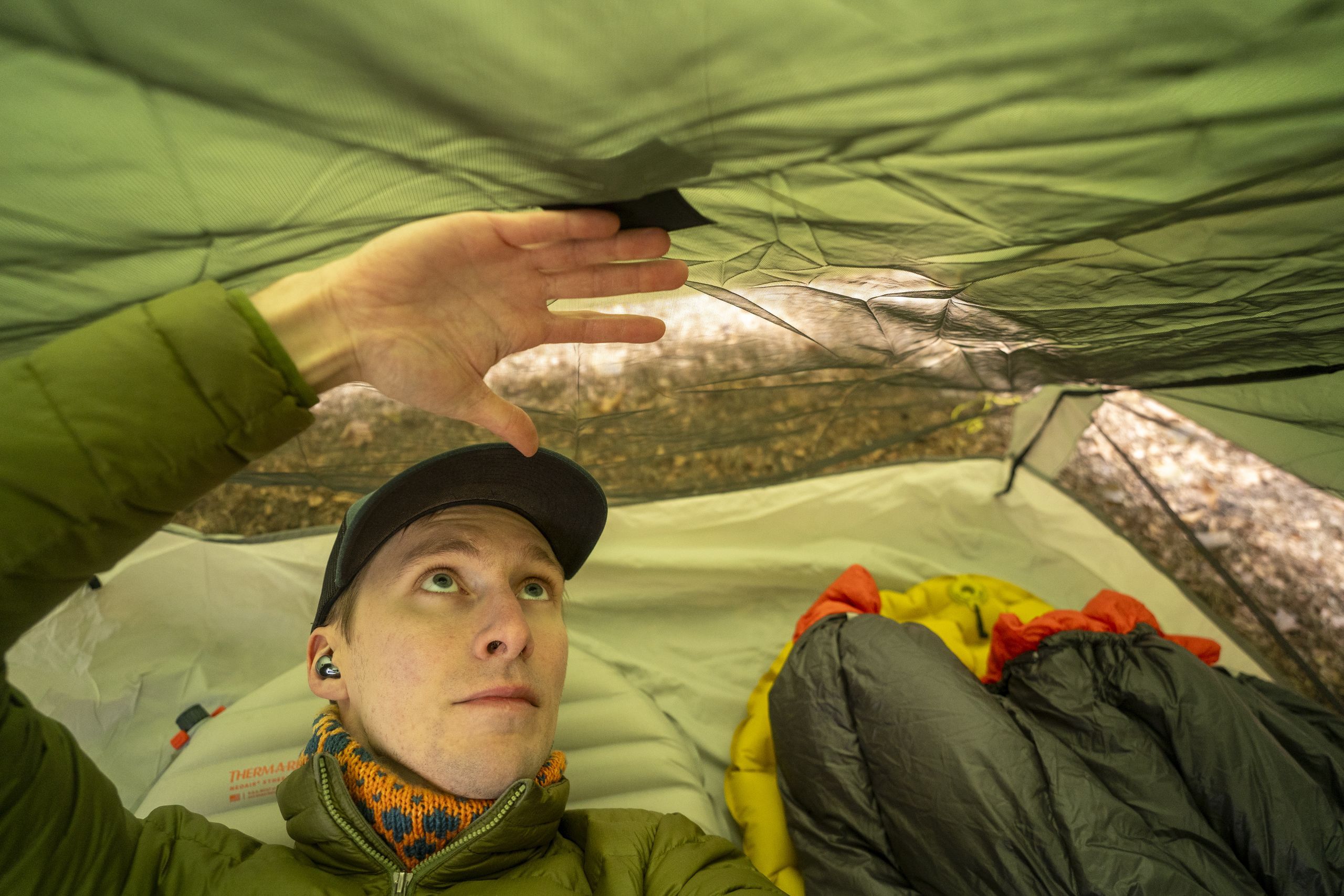
INTERIOR SIZE
Ultralight backpacking focuses on essential gear for comfort on the trail, particularly interior size, which depends on height. Most tents fit individuals up to six feet tall, so shorter hikers may find shelters generally comfortable. However, those closer to six feet may need to avoid tents that compromise comfort.
Manufacturer claims vary widely; some tents labeled as “fits tall people” leave little room, resulting in our head and feet touching the walls when lying down. While this might not bother everyone, many prefer extra clearance to keep their sleeping bag or quilt dry from condensation.
The interior length isn’t a perfect indicator of comfort. The wall slope limits space usage without contact. Consider that you’ll have at least an inch-thick sleeping pad, a fluffy quilt with two inches of loft, plus your foot’s length. That totals about 14 inches of thickness to factor in. The useful metric is the usable length measured 14 inches above the tent floor. Manufacturers often don’t specify this, and while sites like fitmytent.com visualize it, their database isn’t complete.
Panel pulls are useful for maximizing space. These attachment points at the head and foot areas can be staked out to pull the fabric away, increasing livable area. They also stabilize the fabric in strong winds and reduce flapping.
However, they add weight and complexity to setups. We prefer tents without them, but they can enhance certain models. In our testing, we aim to indicate whether a tent will be comfortable for individuals around and above six feet tall. The standout options are the two Durston X-Mid Pro models, which provide exceptional sleeping length for taller users and ranked as our most comfortable models.
The two Zpacks models, the Offset Duo and Pivot Solo, also deliver excellent performance, with the Pivot Solo uniquely designed to eliminate the worry of a wet footbox by incorporating a second pole that places mesh at the foot end. The Tarptent DoubleRainbow deserves praise as well; its single arched pole creates ample usable space at the head and foot areas due to the nearly vertical sidewalls, allowing for a very comfortable sleeping experience when using it.
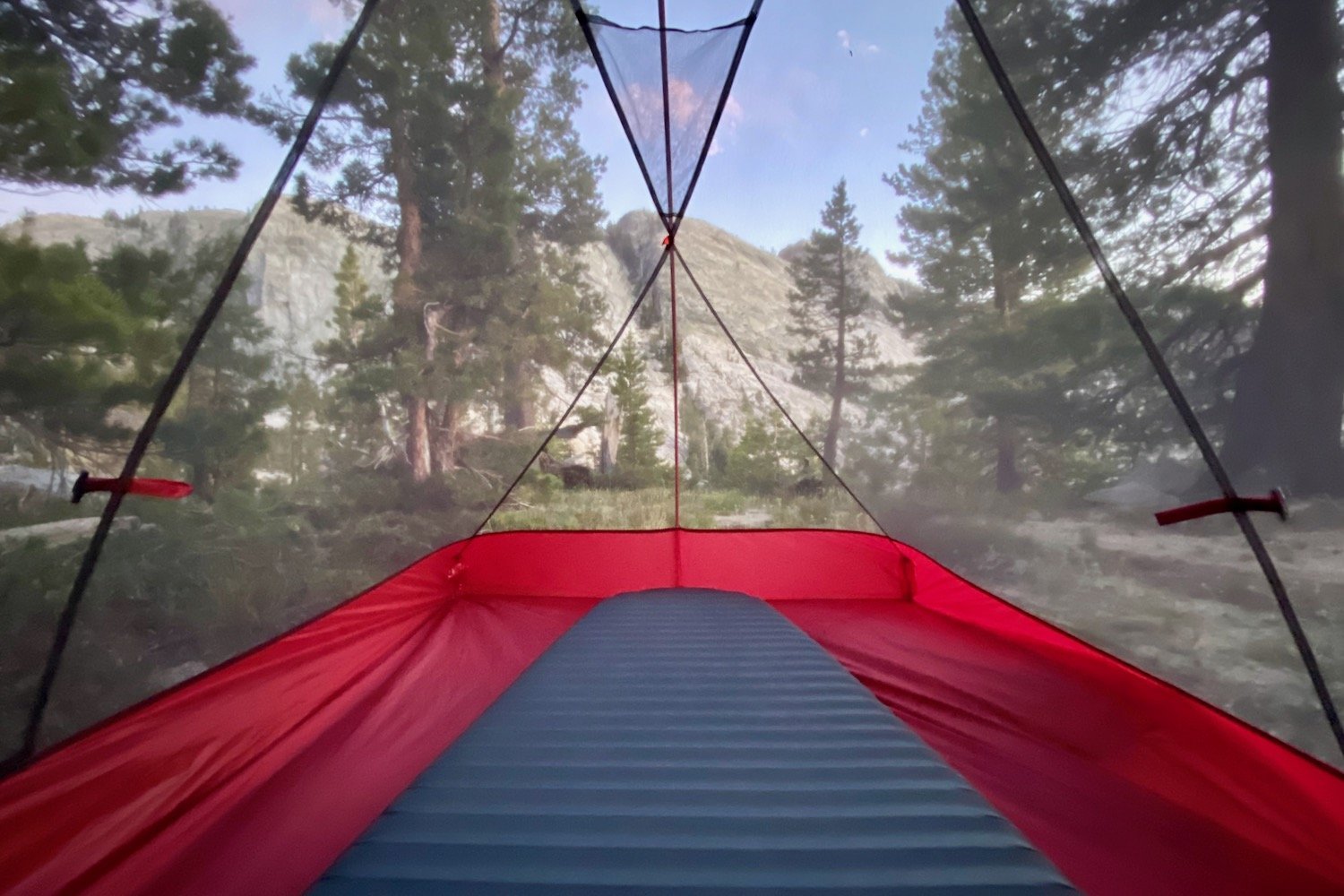
FEATURES
Ultralight tents offer many features, making it hard to choose which to invest in. We focus on those appealing to most, but niche options may resonate with you, so consider exploring beyond our picks if something catches your interest.
We focused on key features. Large vestibules are essential for storing backpacks and shoes while sleeping. Having a rain-protected vestibule, even with the main door open for airflow, is beneficial. If you sleep with the doors partly open and it drizzles, your gear remains dry. The size and type of doors are crucial- cramped doors are uncomfortable to use, especially near condensation-heavy tent walls.
Rainbow-shaped doors work for most conditions, but we prefer L-shaped doors for better bug protection and stability. Generous interior pockets near the doors help keep the tent organized. Peak vents manage condensation, and adding kickstands, stiff rims, or guy line attachments to hold them open is advantageous. We also favor guy line attachments on the peaks and middle for wind resistance during storms.
There are also some unique features that not all tents possess. The Tarptent Double Rainbow allows trekking poles to be attached at the staking corners to convert the tent into freestanding mode, which can greatly assist on trails like the Appalachian Trail, where tent platforms are common. The Double Rainbow can also utilize trekking poles to hold open the doors and create an awning with a hidden flap between the door sections. This is wonderful for those days spent waiting for a rainstorm to pass, as opening the doors helps prevent the tent from feeling too claustrophobic.
The list of tent features goes on and on, and the full list is outside of the scope of this article, so research on your own and explore the wonderful world of ingenious designs manufacturers have come up with.
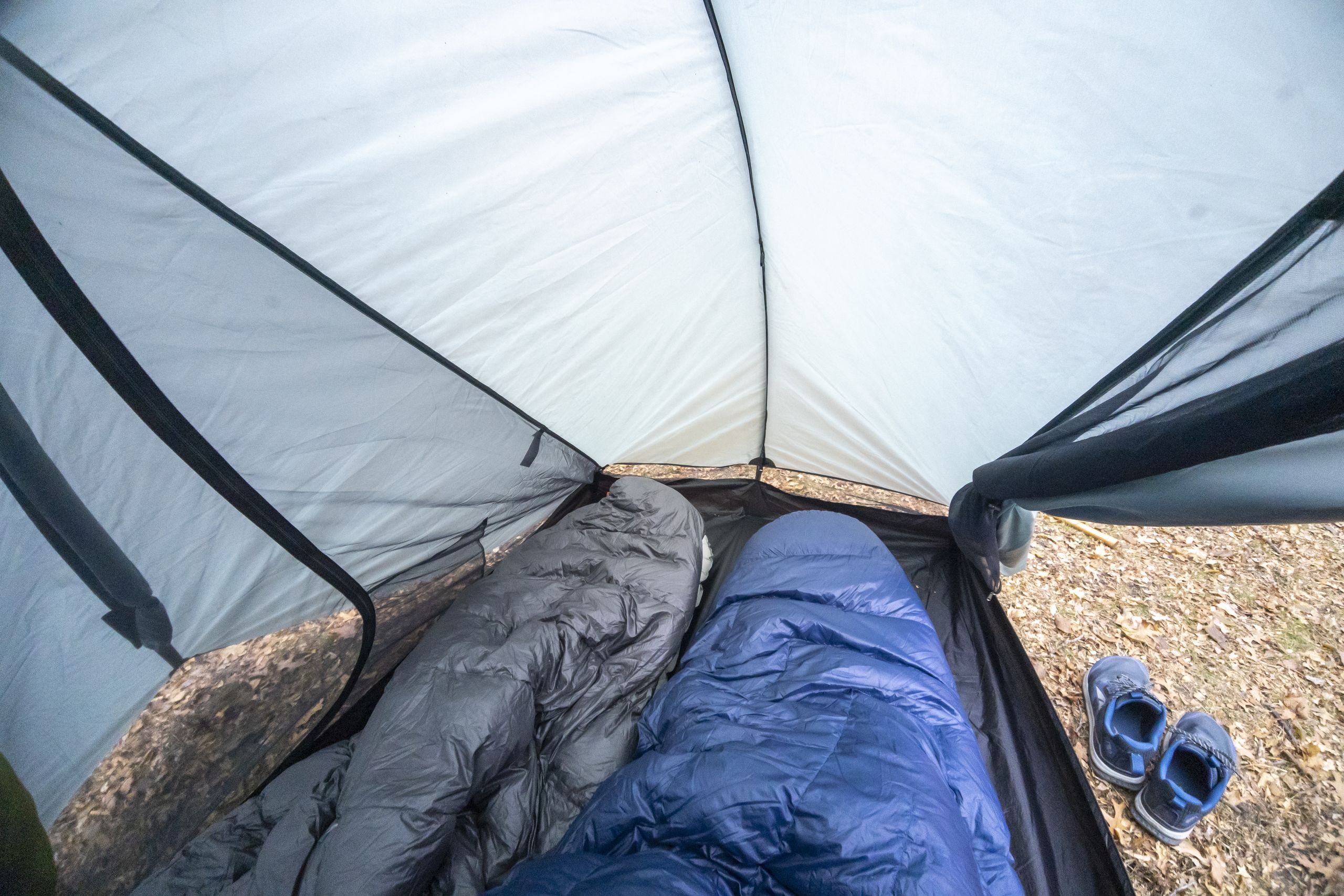
DOUBLE VS SINGLE WALL
The debate over double versus single wall designs depends on personal preference. A double wall features an additional mesh layer between you and the rainfly, allowing for separation; the mesh clips into the rainfly in trekking pole tents or rests on top in traditional pole tents. Single wall designs eliminate this mesh, sewing the doors directly to the fabric, resulting in a lighter but less modular option.
We want to address a common misconception about single vs double wall tents regarding condensation. While double wall tents are said to offer better protection, this misleads people into thinking they are inherently more resistant to condensation. Under the same conditions with identical designs and fabrics, both tent types form the same amount of condensation. A mesh interior doesn’t inherently reduce condensation. While extra mesh may disrupt airflow, it doesn’t block moisture; condensation results from temperature differences and air humidity. We’re not shaming anyone for this belief – it’s among many backpacking myths – but understanding condensation helps make informed tent purchase decisions.
What a double wall construction helps with is preventing you from touching the wet walls of the tent. Your sleeping bag stays in a dry area, your clothes won’t accidentally soak up water when brushing against the walls, and it can also help block some misting. Misting occurs when condensation forms on the sidewalls of the tent, but persistent raindrops and wind knock it off the fabric and onto the interior. It often appears that a tent isn’t actually waterproof because it feels like it’s raining inside your tent. This is an unavoidable symptom of humid weather and rain, and it’s often found at higher elevations when you’re inside the storm clouds themselves.
In general, we believe that single wall tents – with sufficient space – are the best choice for an ultralight setup. However, this depends heavily on the environment you’re heading into. If you frequently backpack in humid areas – such as Scotland, the Appalachian Trail, or the Boundary Waters – a double wall tent may provide added comfort.
Additionally, some people appreciate the modularity of being able to pitch only the rainfly or just the net tent for stargazing. However, if you mostly find yourself in less humid conditions – like Colorado, the Pacific Crest Trail (excluding Washington), or any desert – you will likely only encounter condensation occasionally, making a single wall design worth the weight savings.
Conclusion
Ultralight tents provide one of the best ways to reduce significant weight from your back while on the trail. This category has evolved from a collection of niche tarp designs to companies offering full backcountry accommodations that surpass the comfort of even traditional backpacking tents. CleverHiker is dedicated to helping you find the best tent for your needs, and we hope that regardless of your camping style, this guide has assisted you in achieving good sleep and happy shoulders on any adventure.
